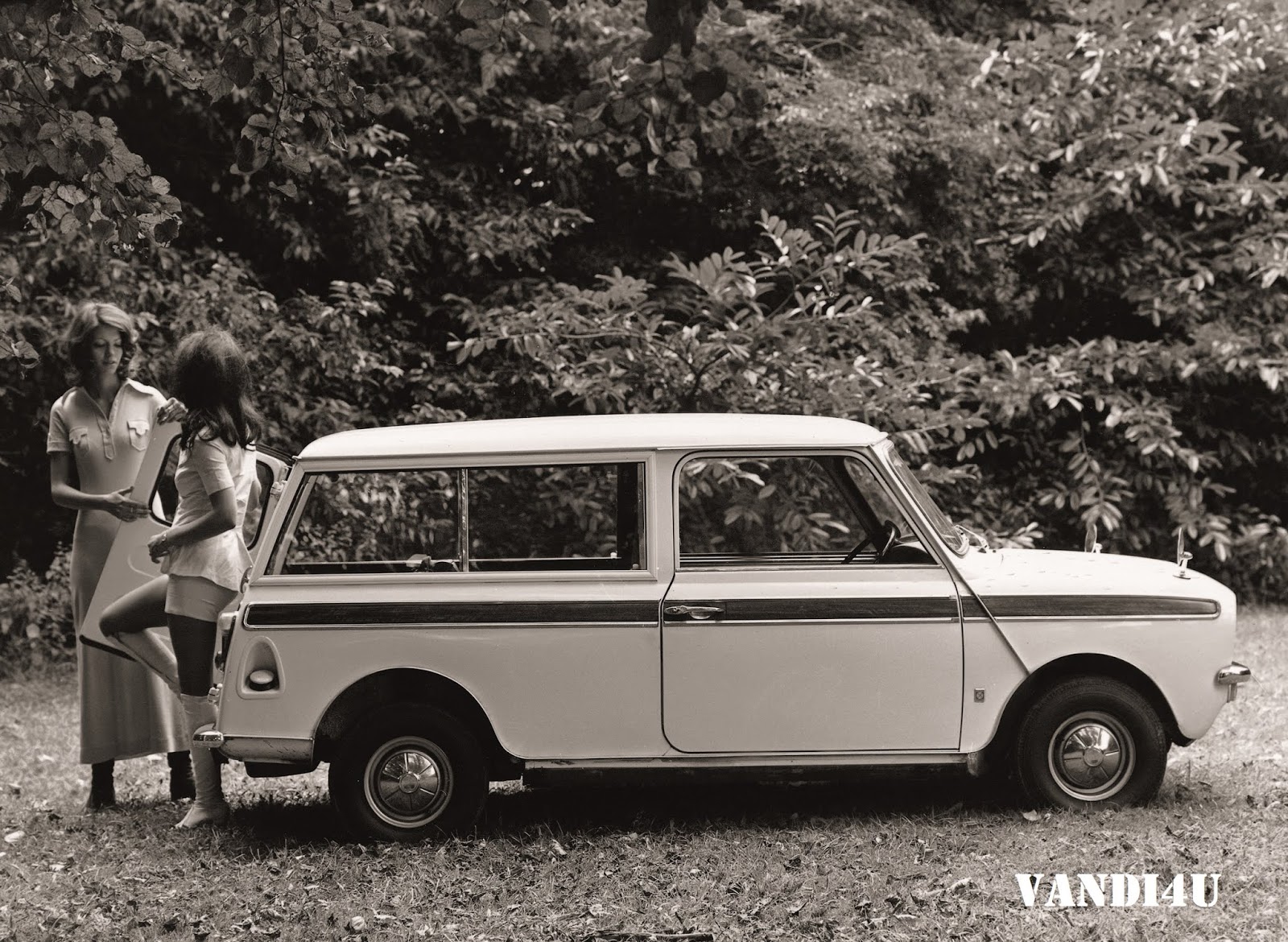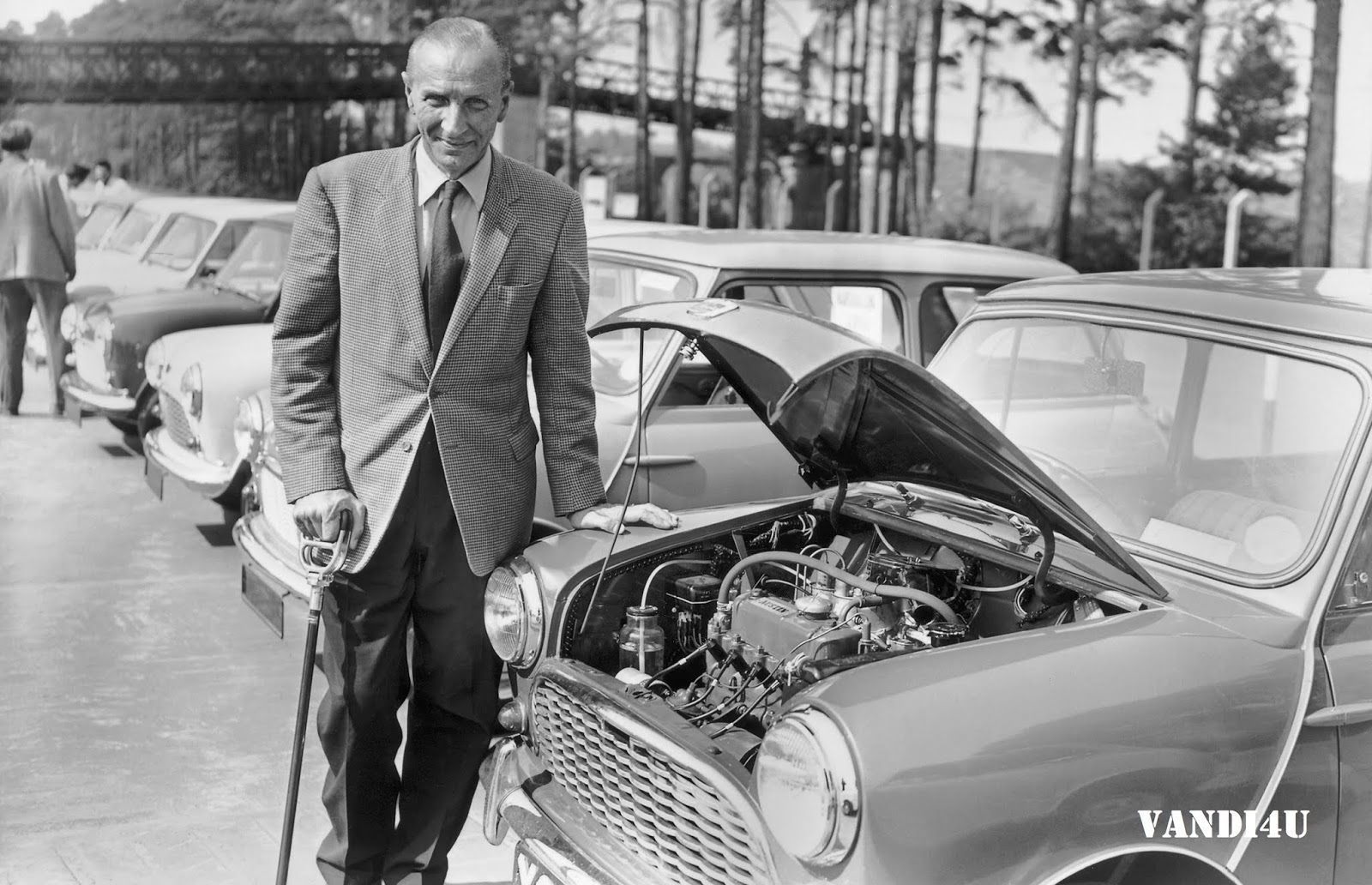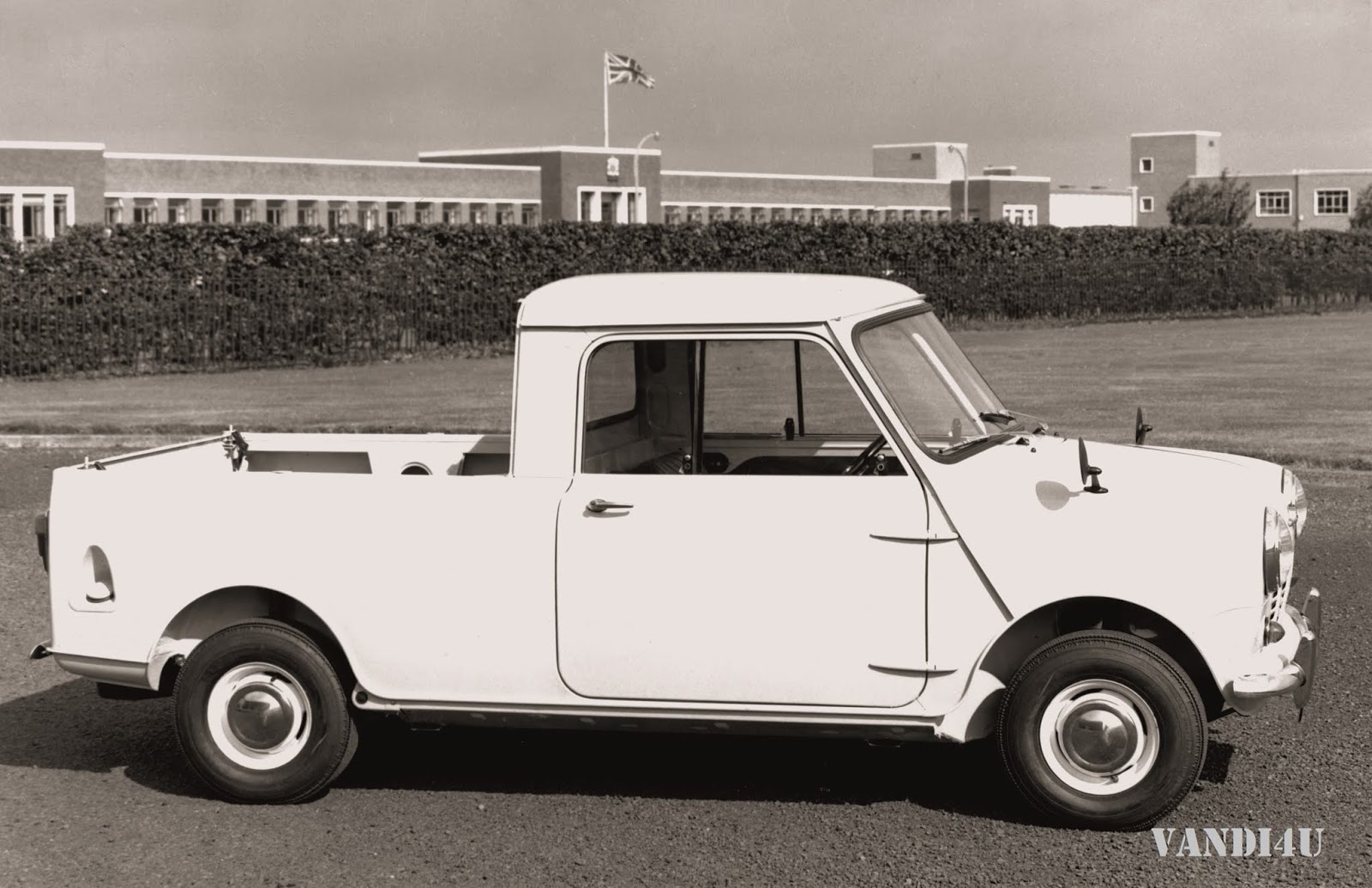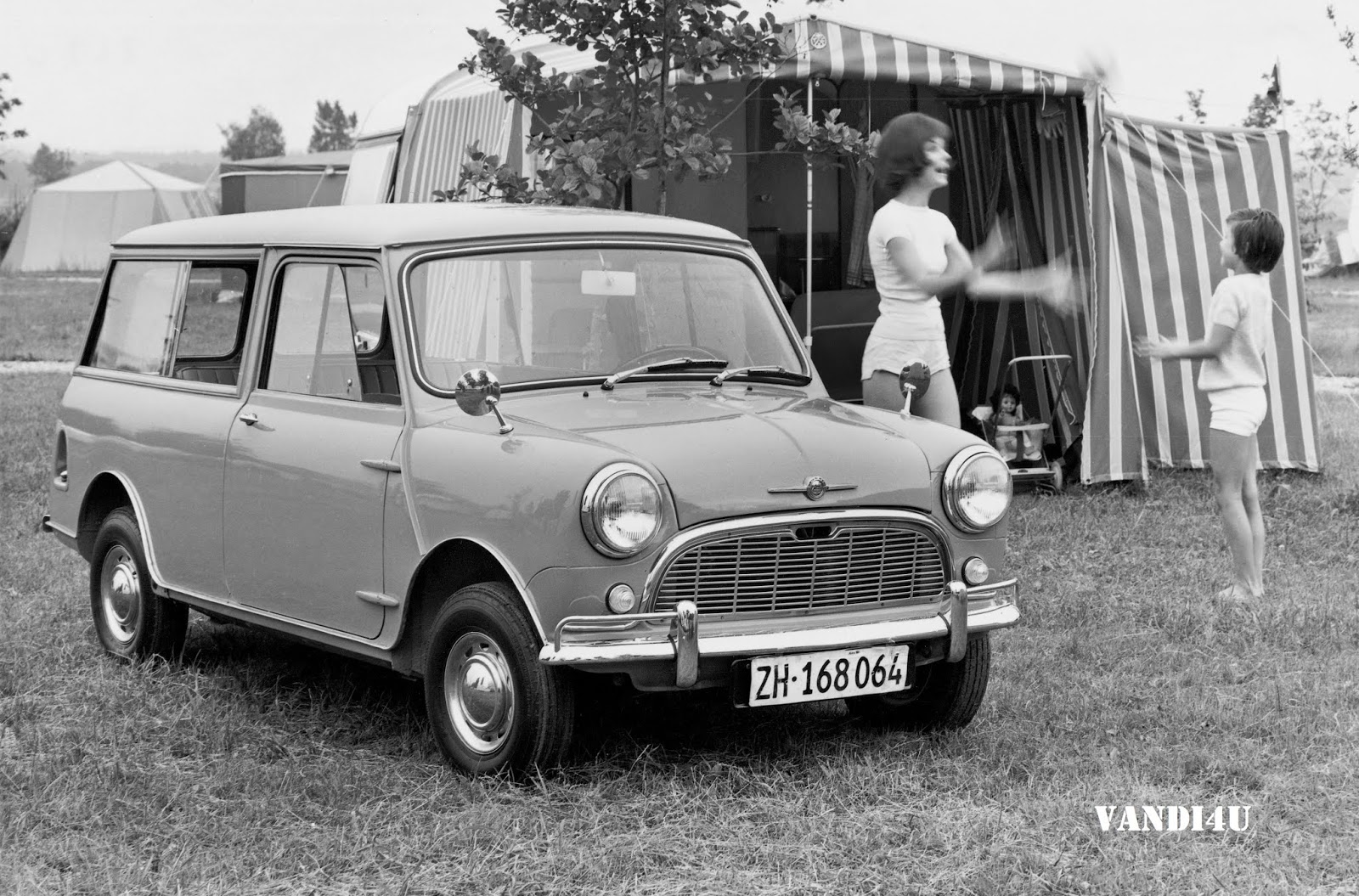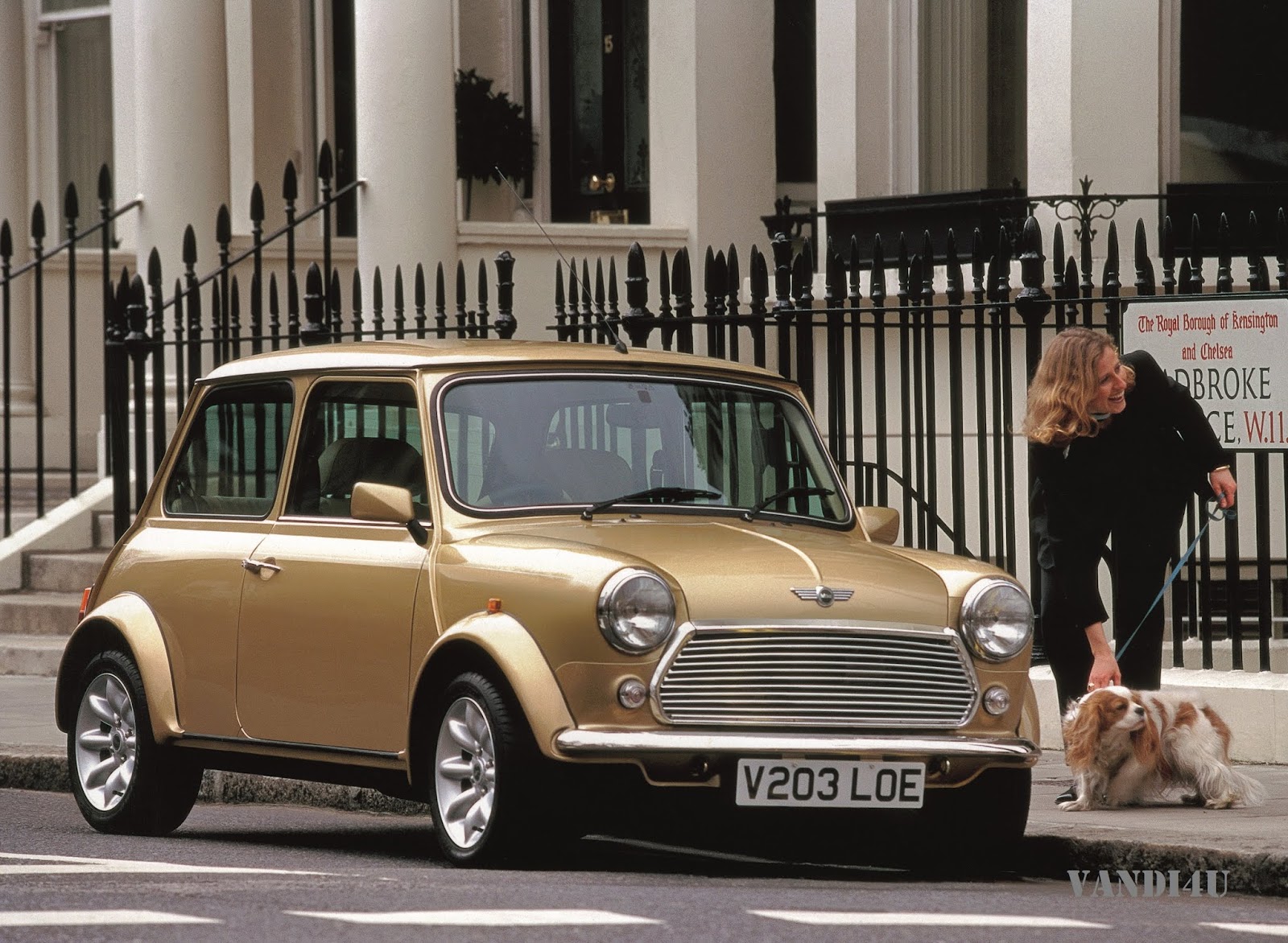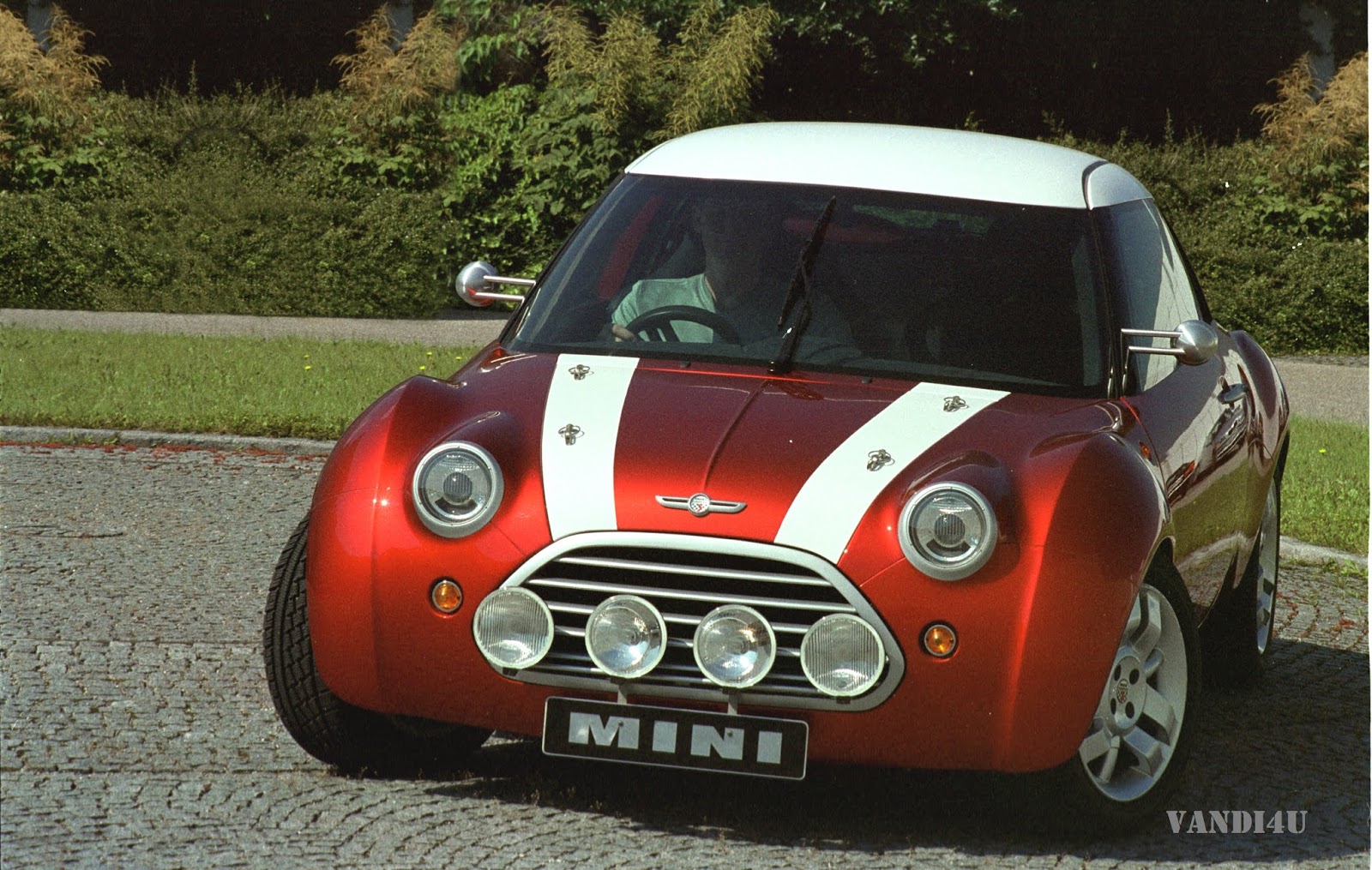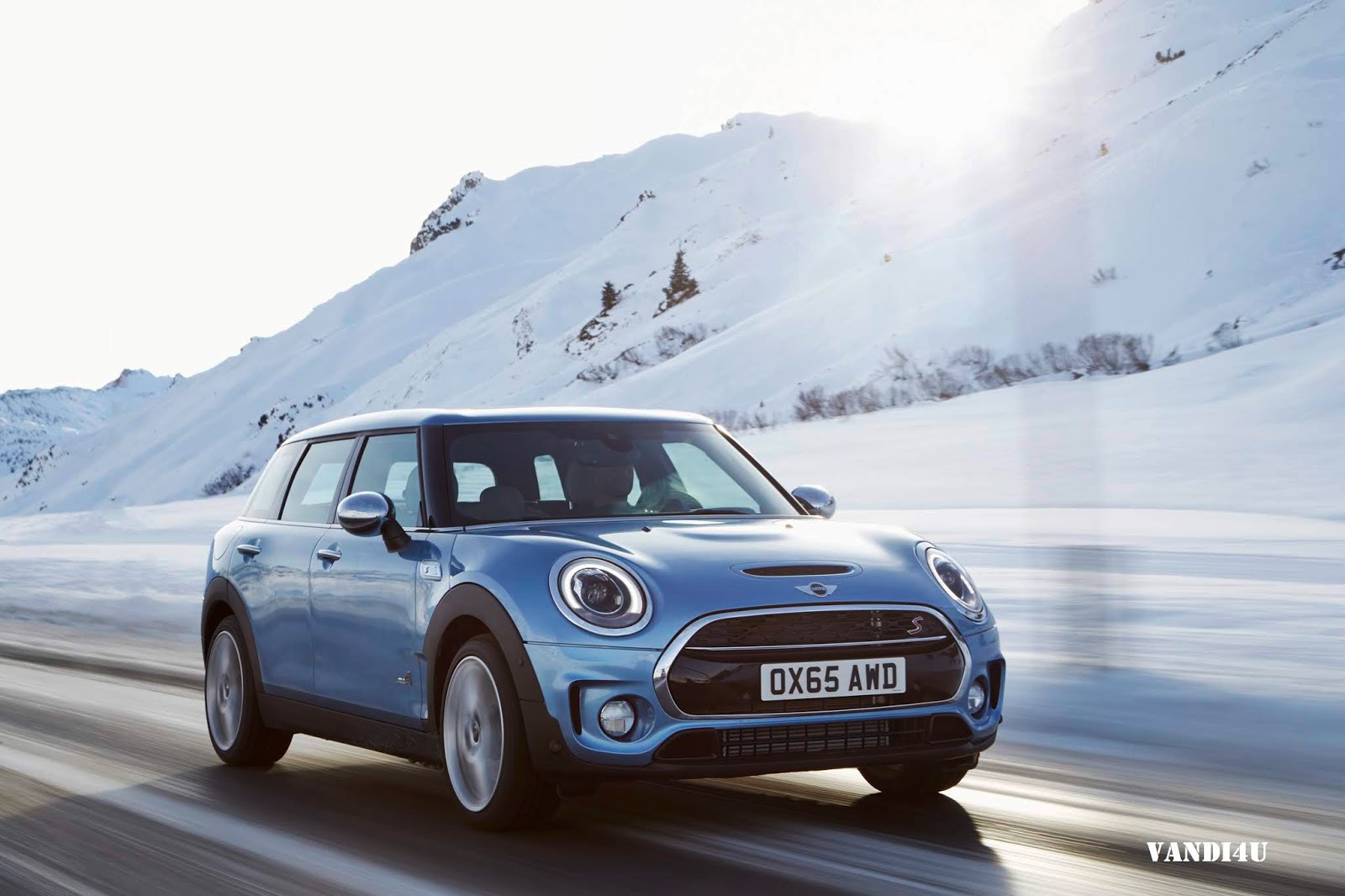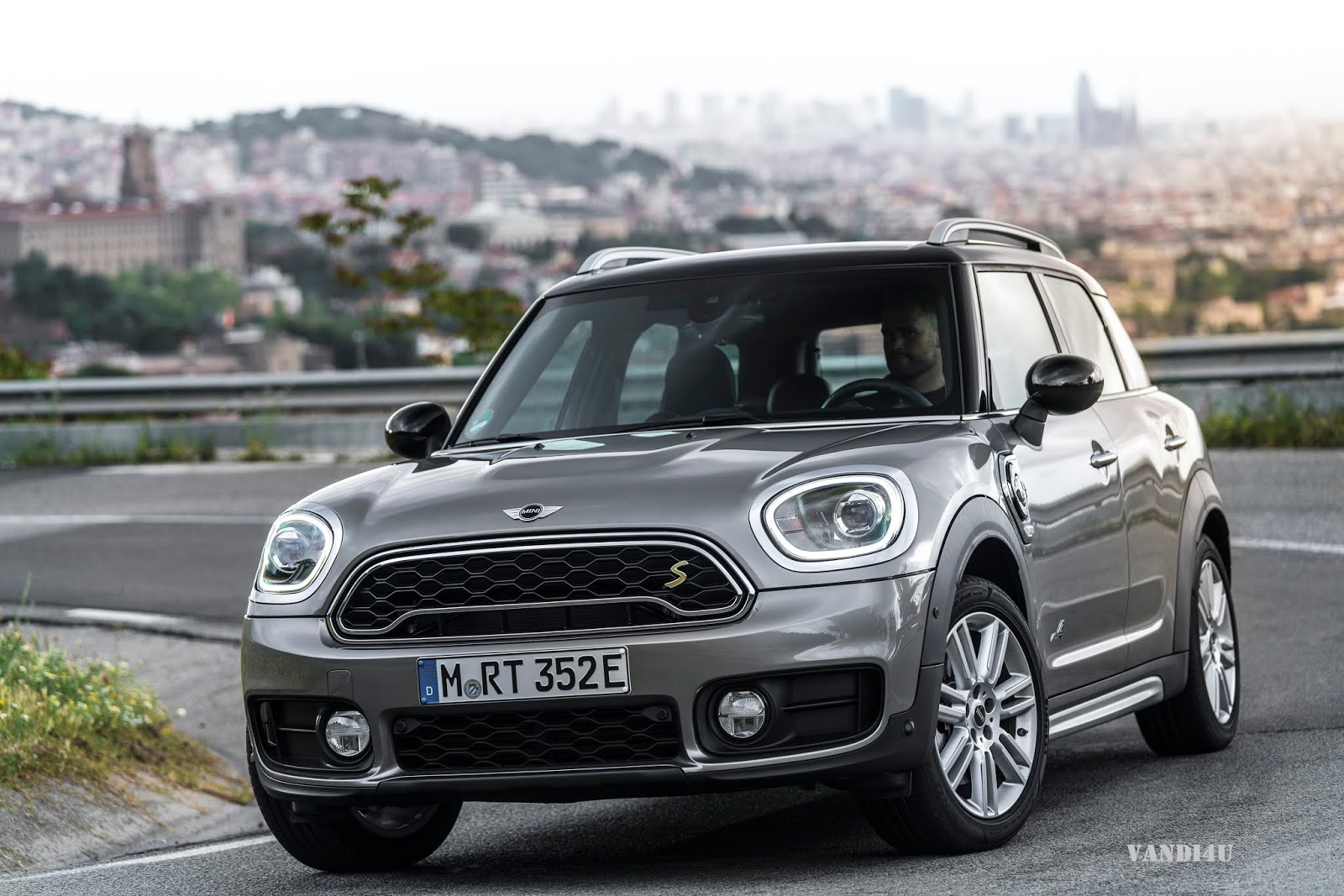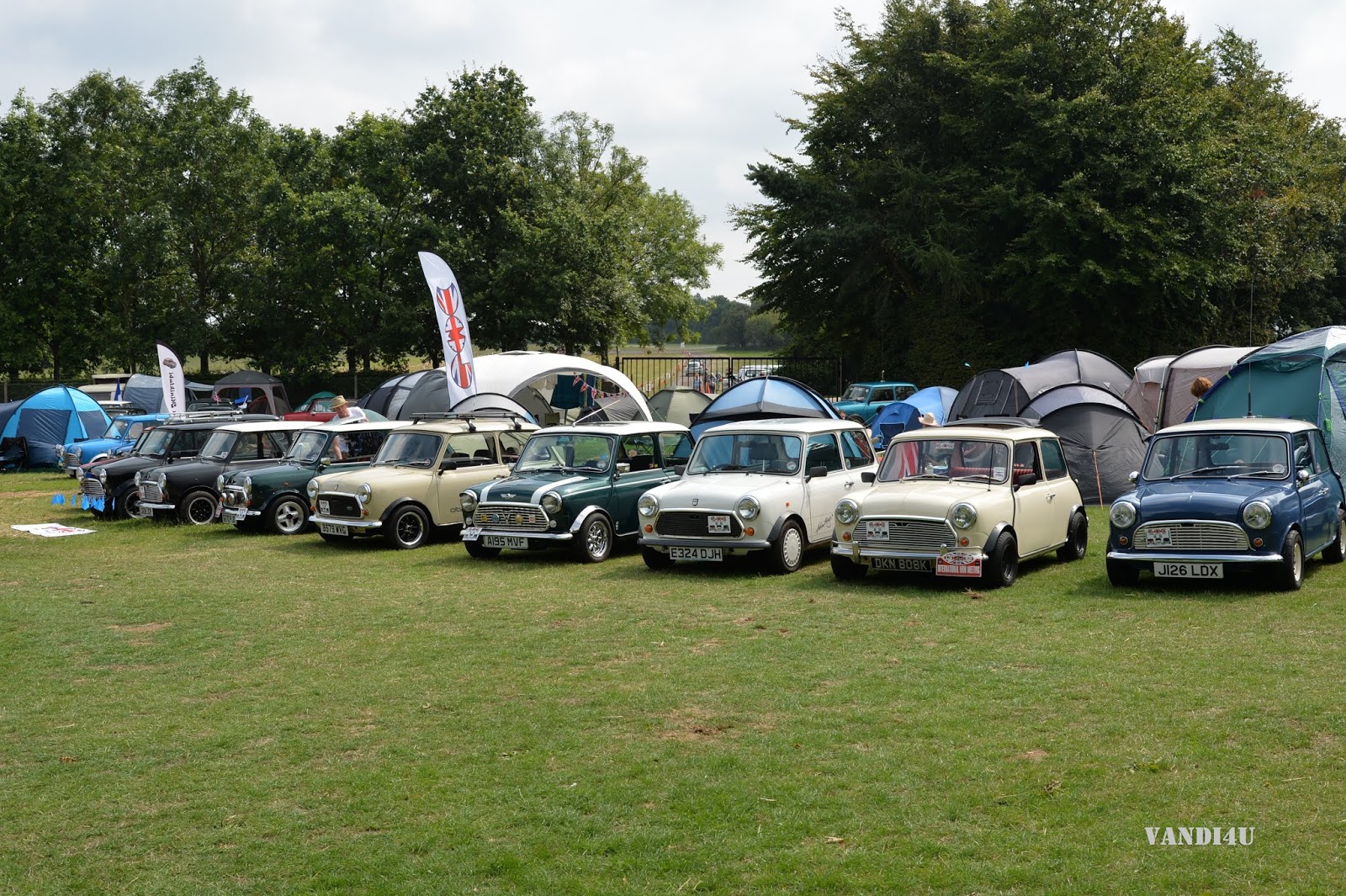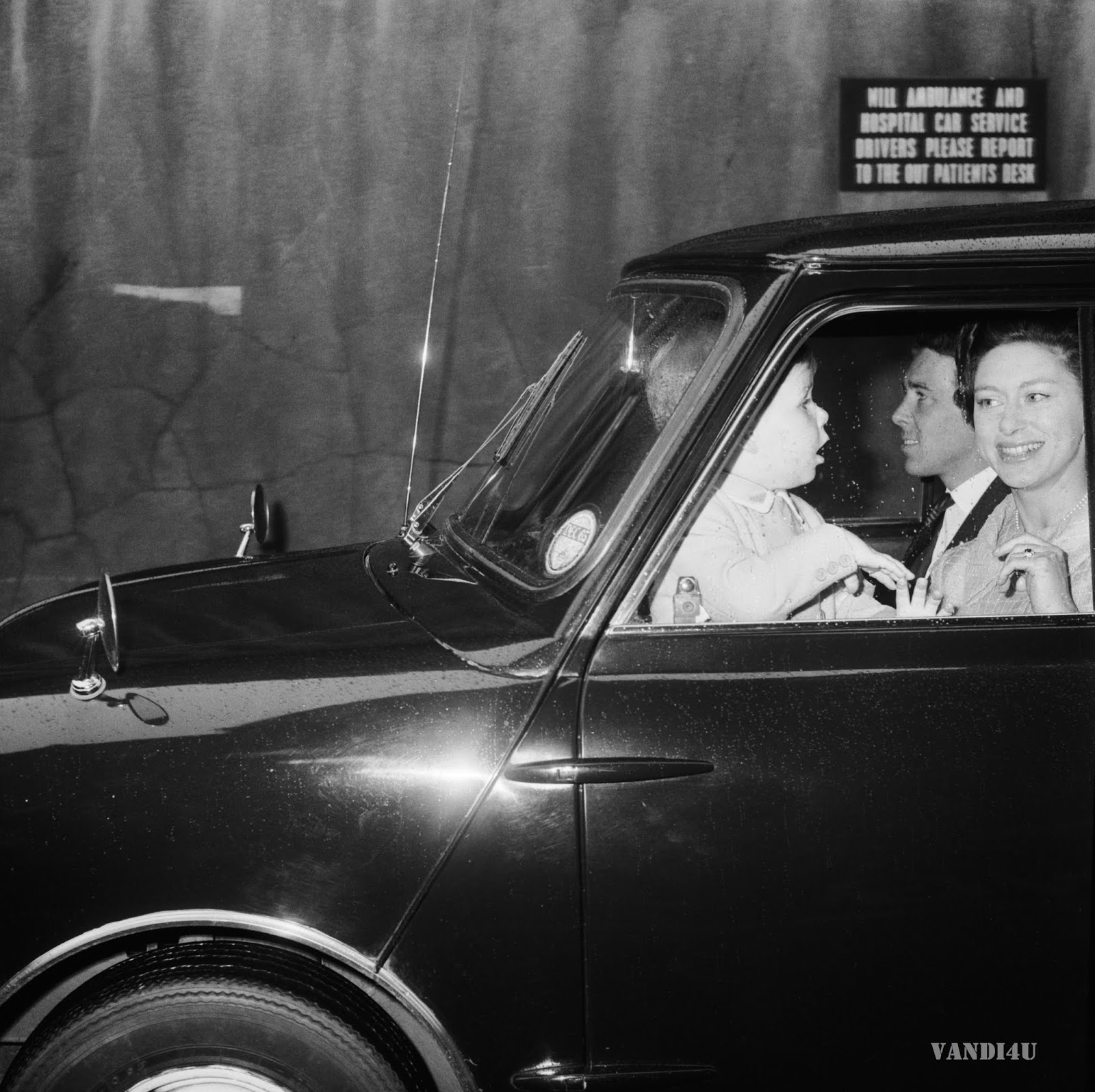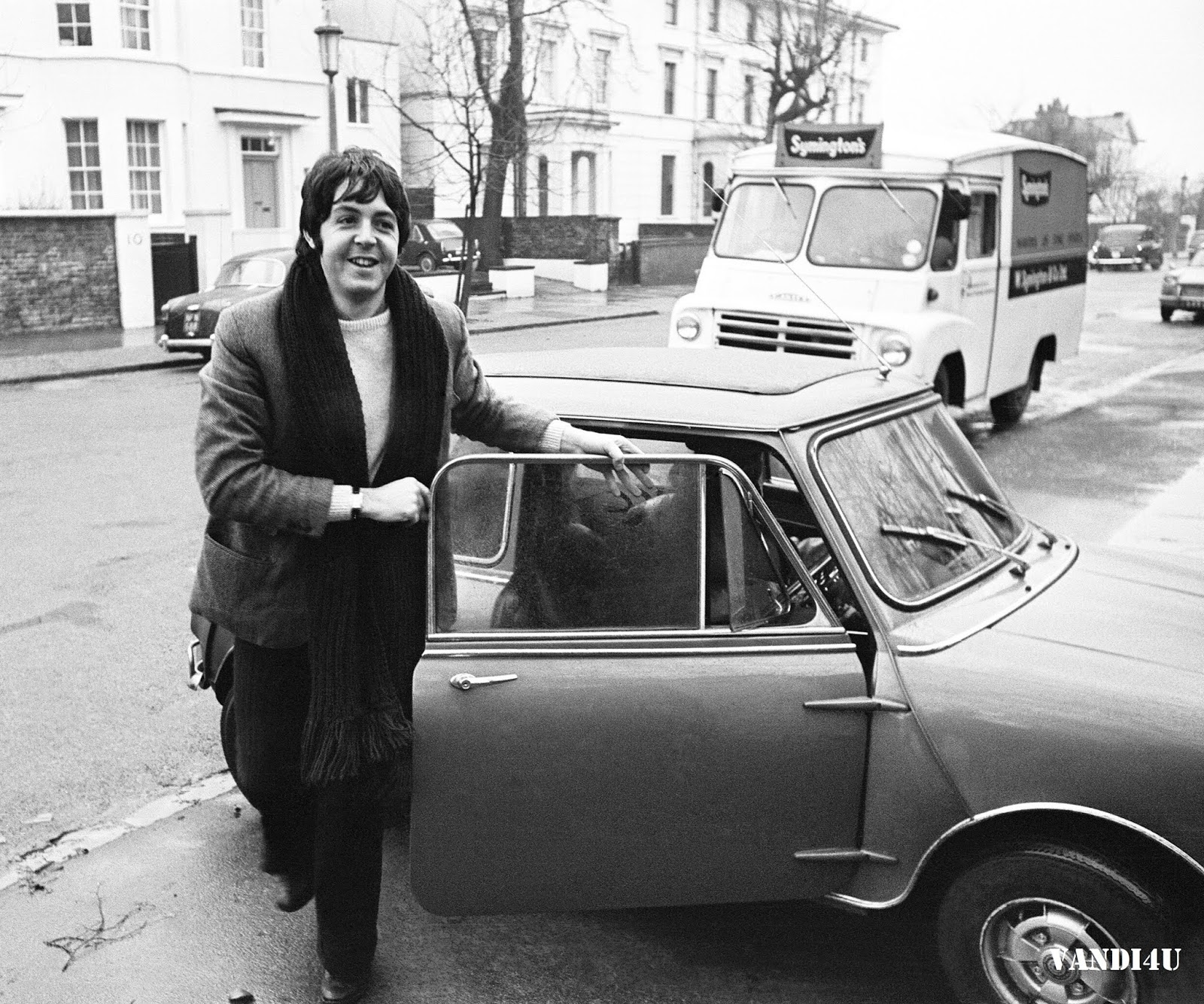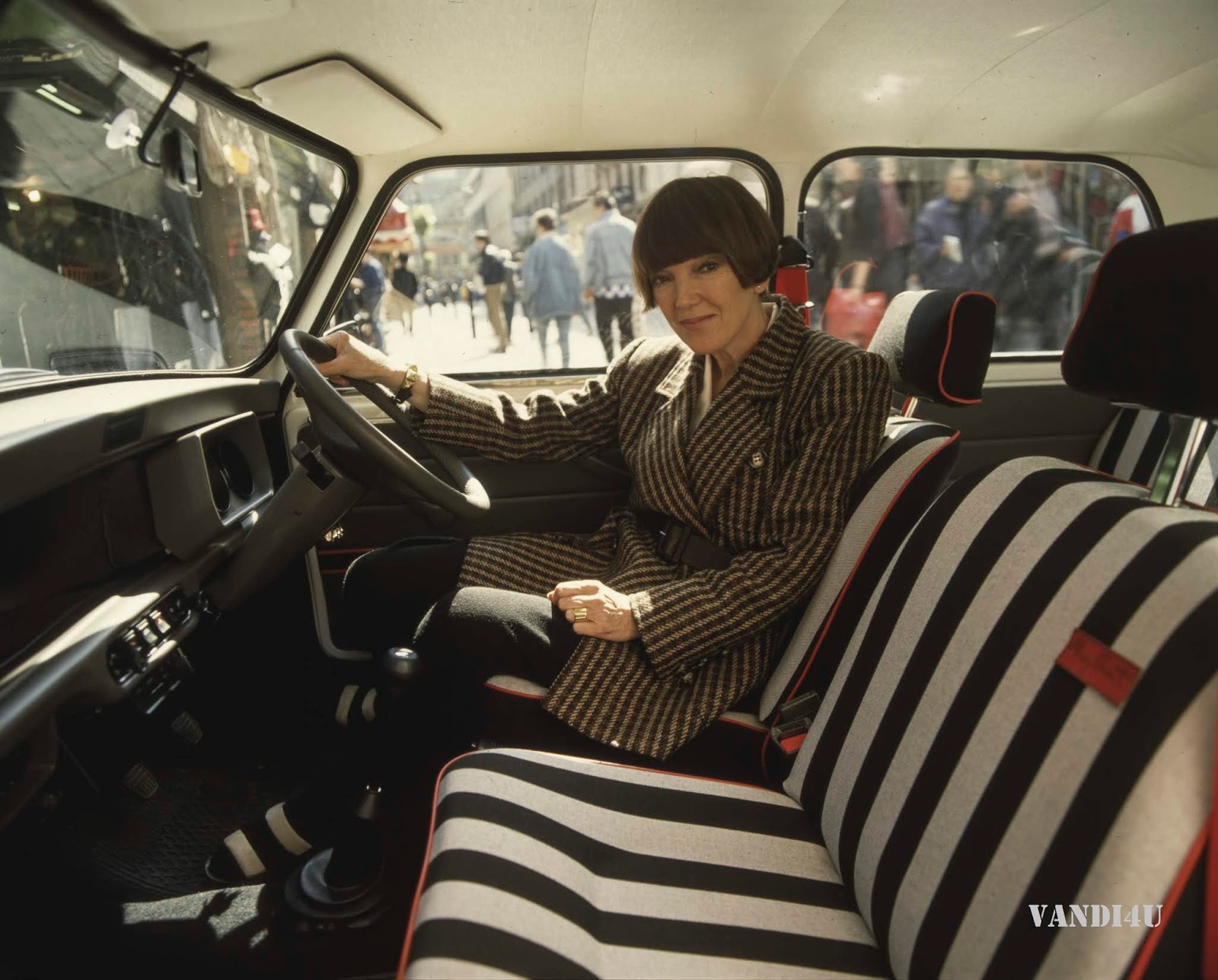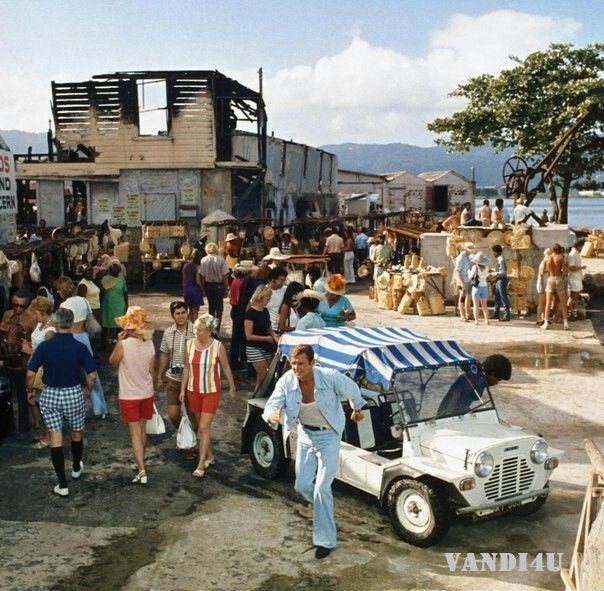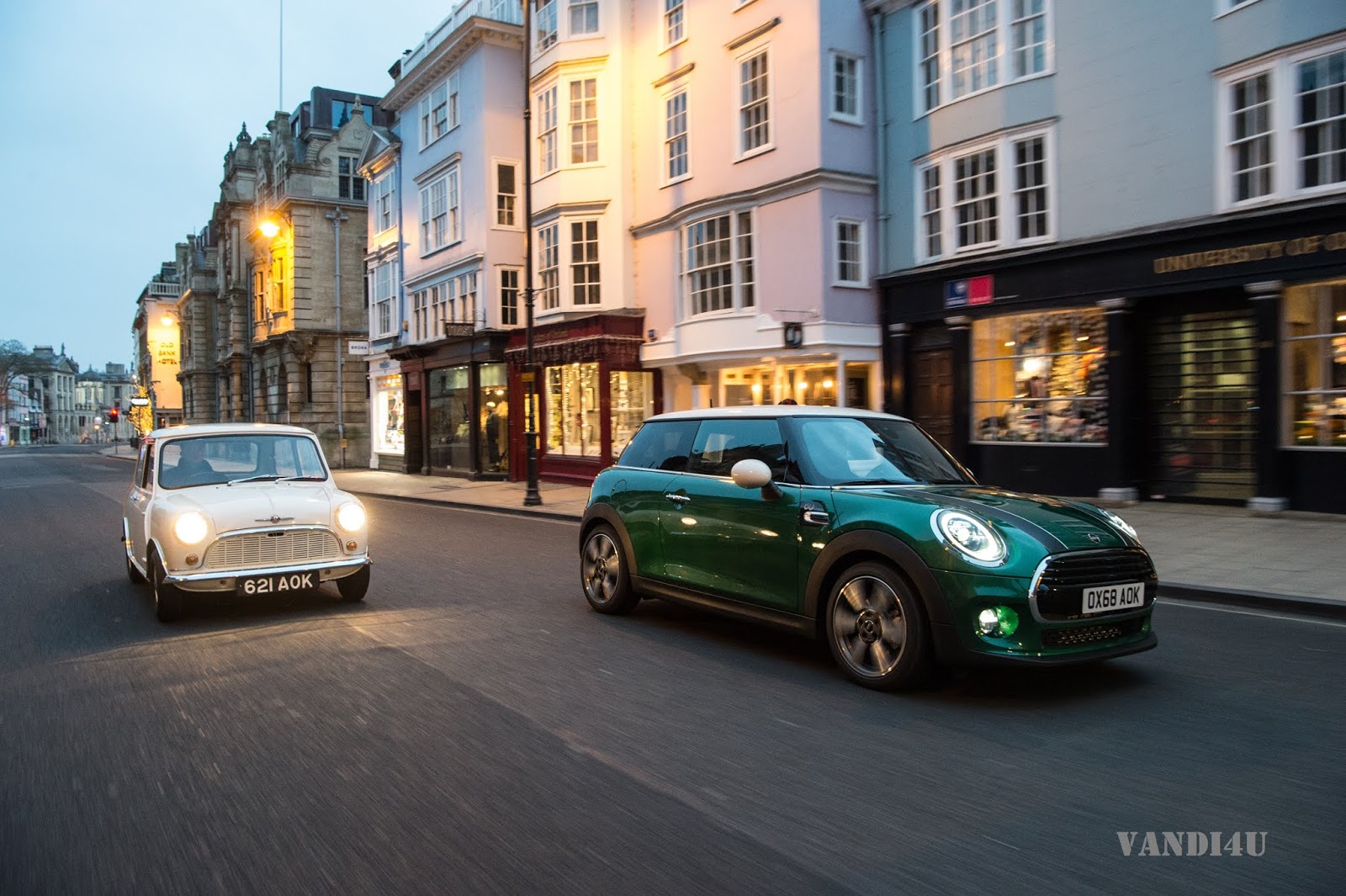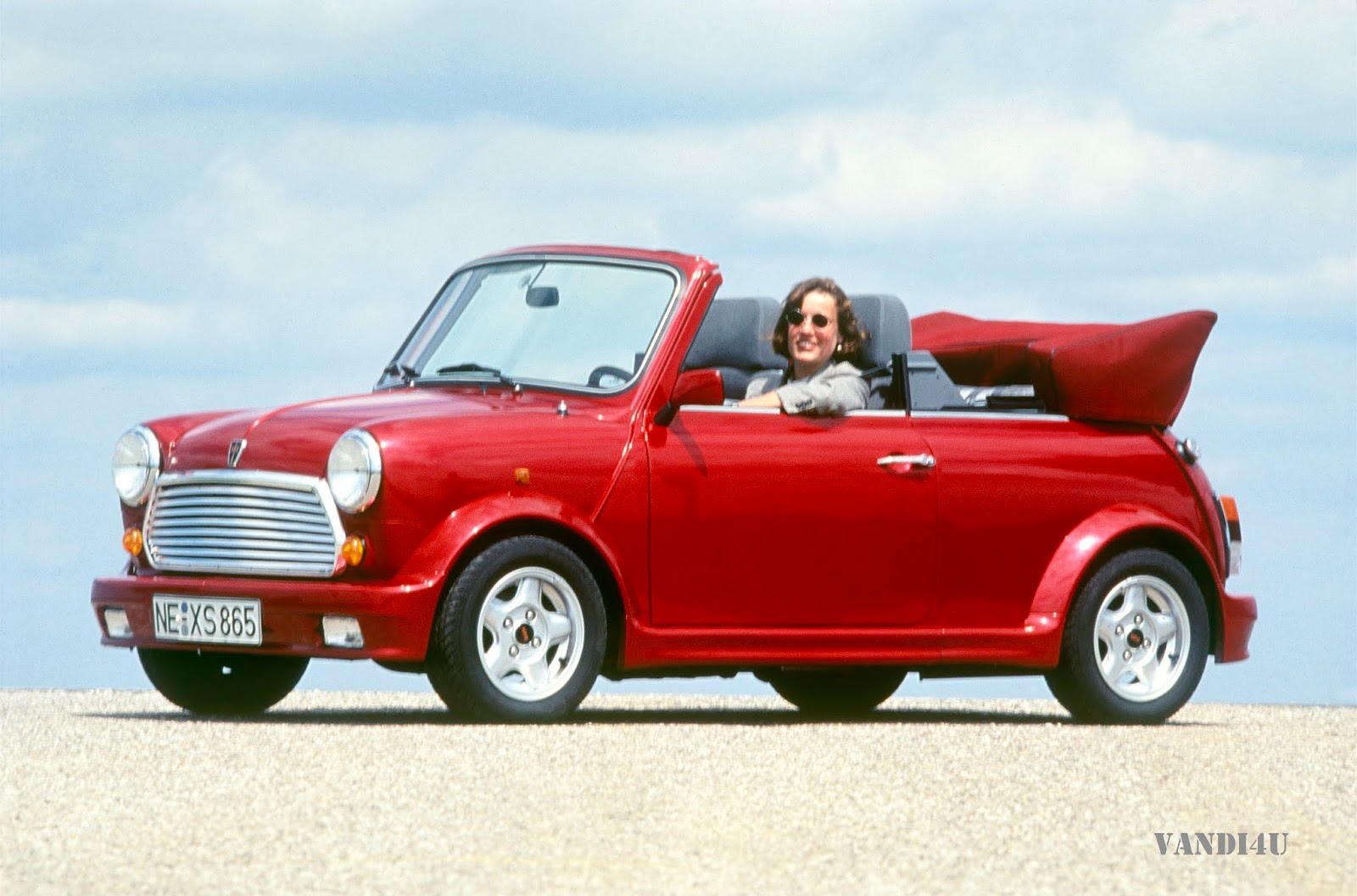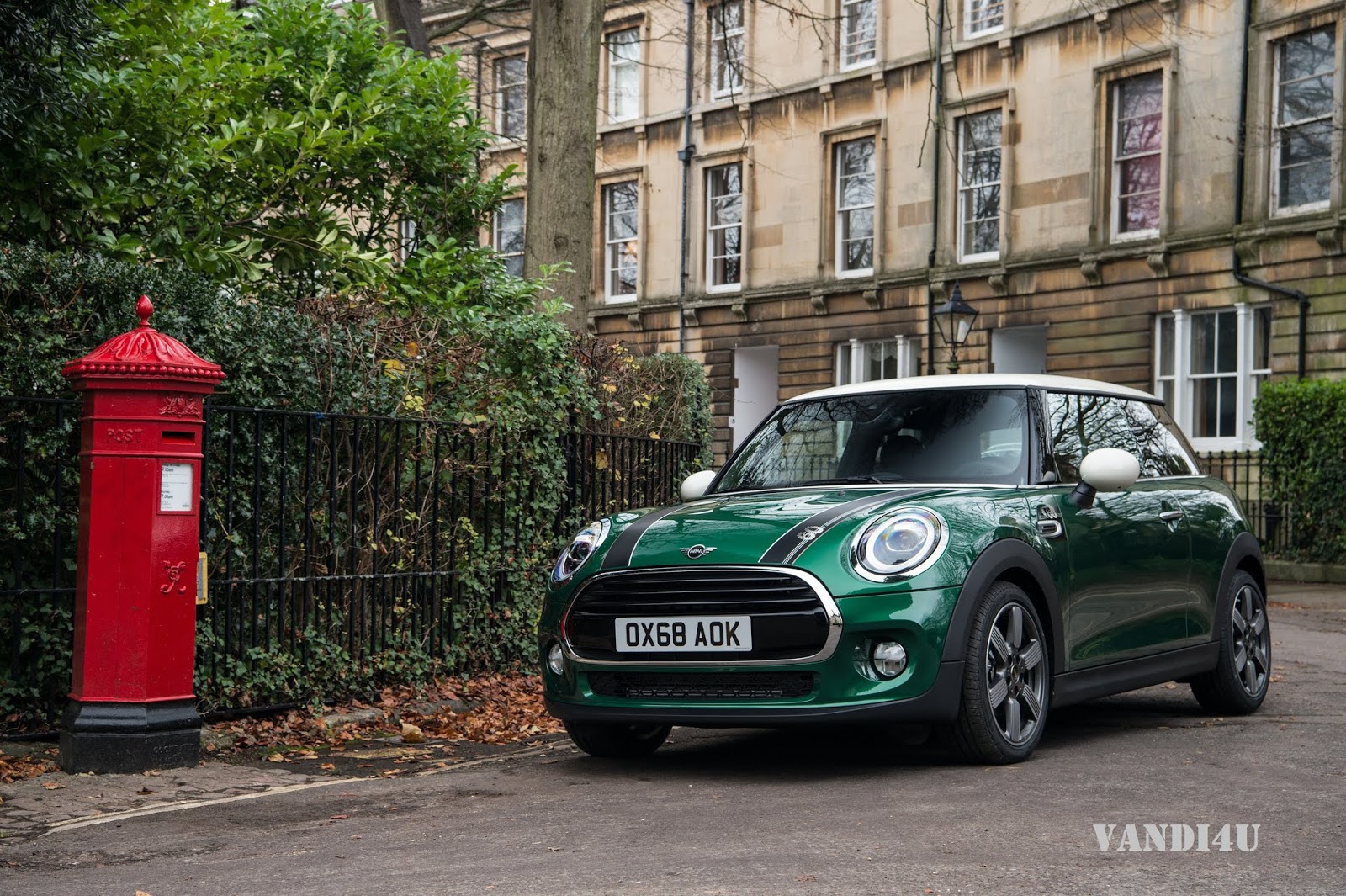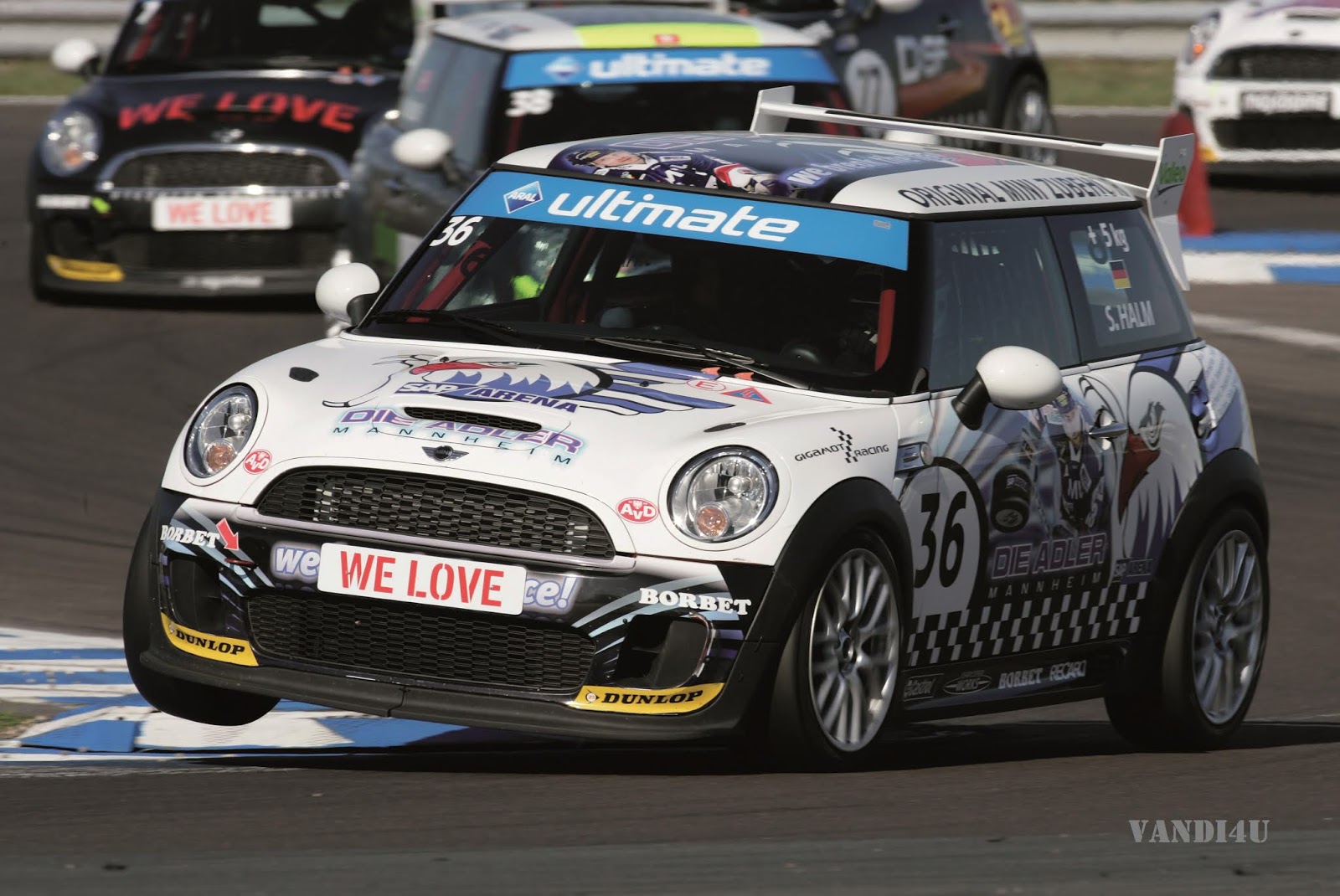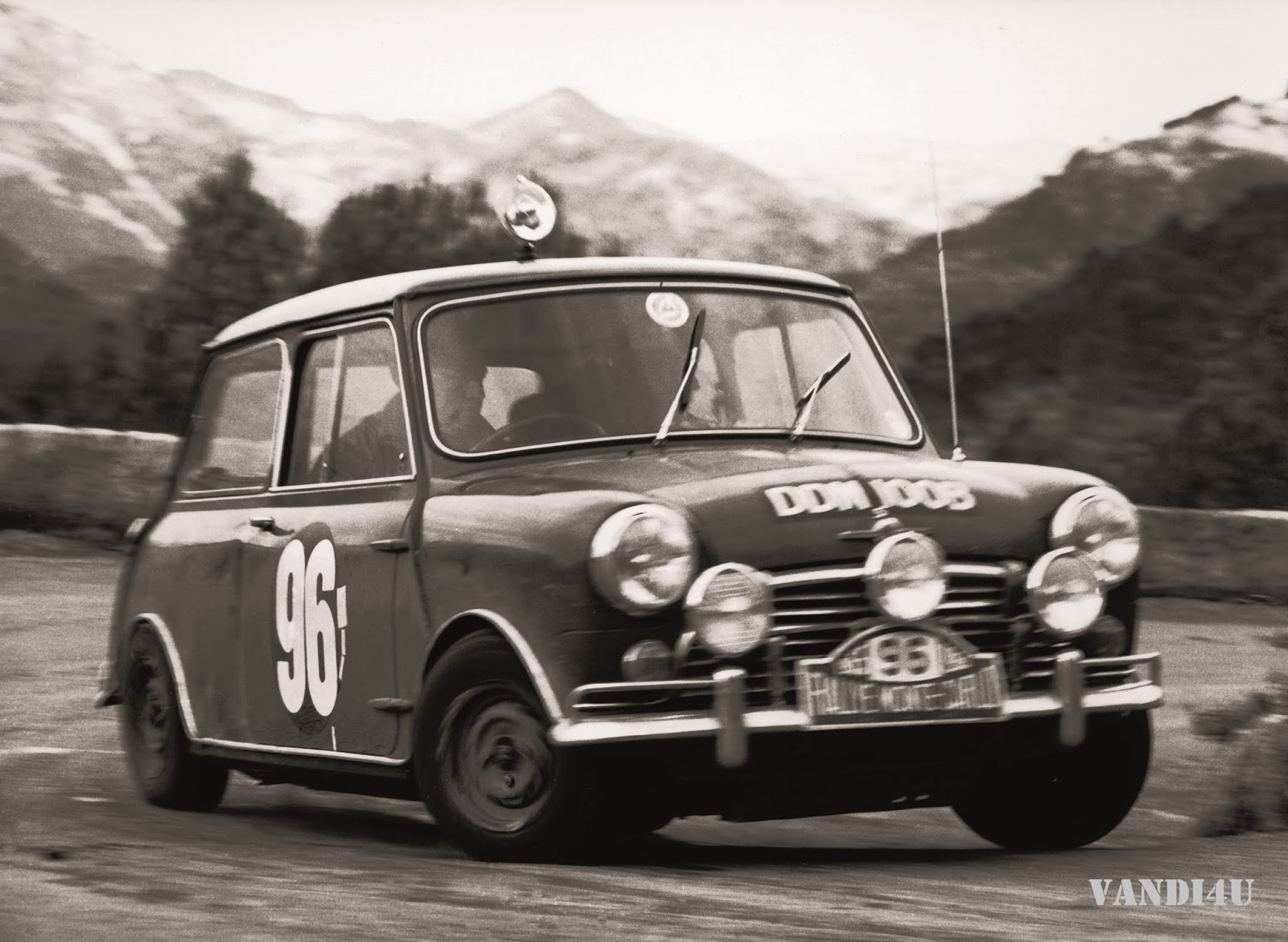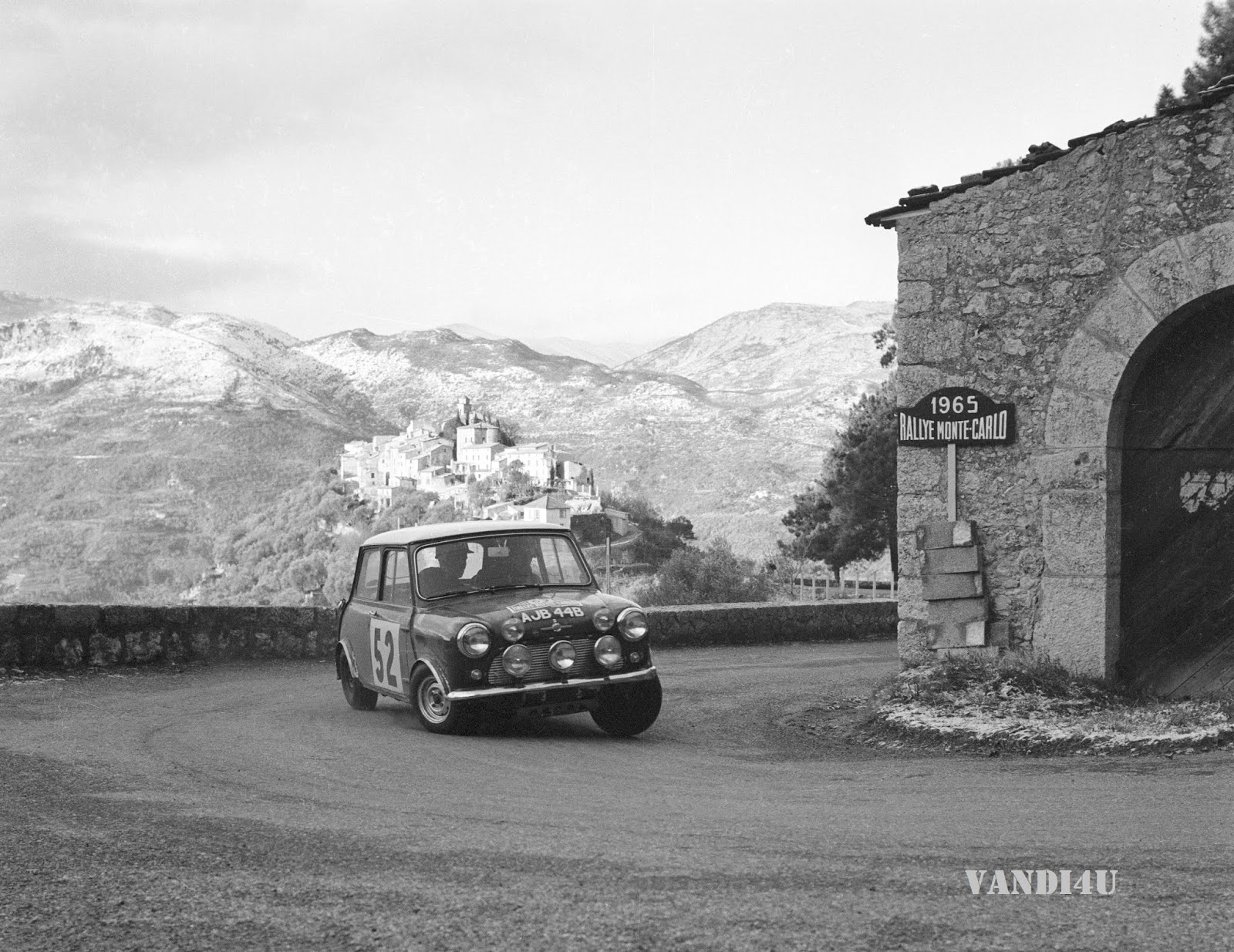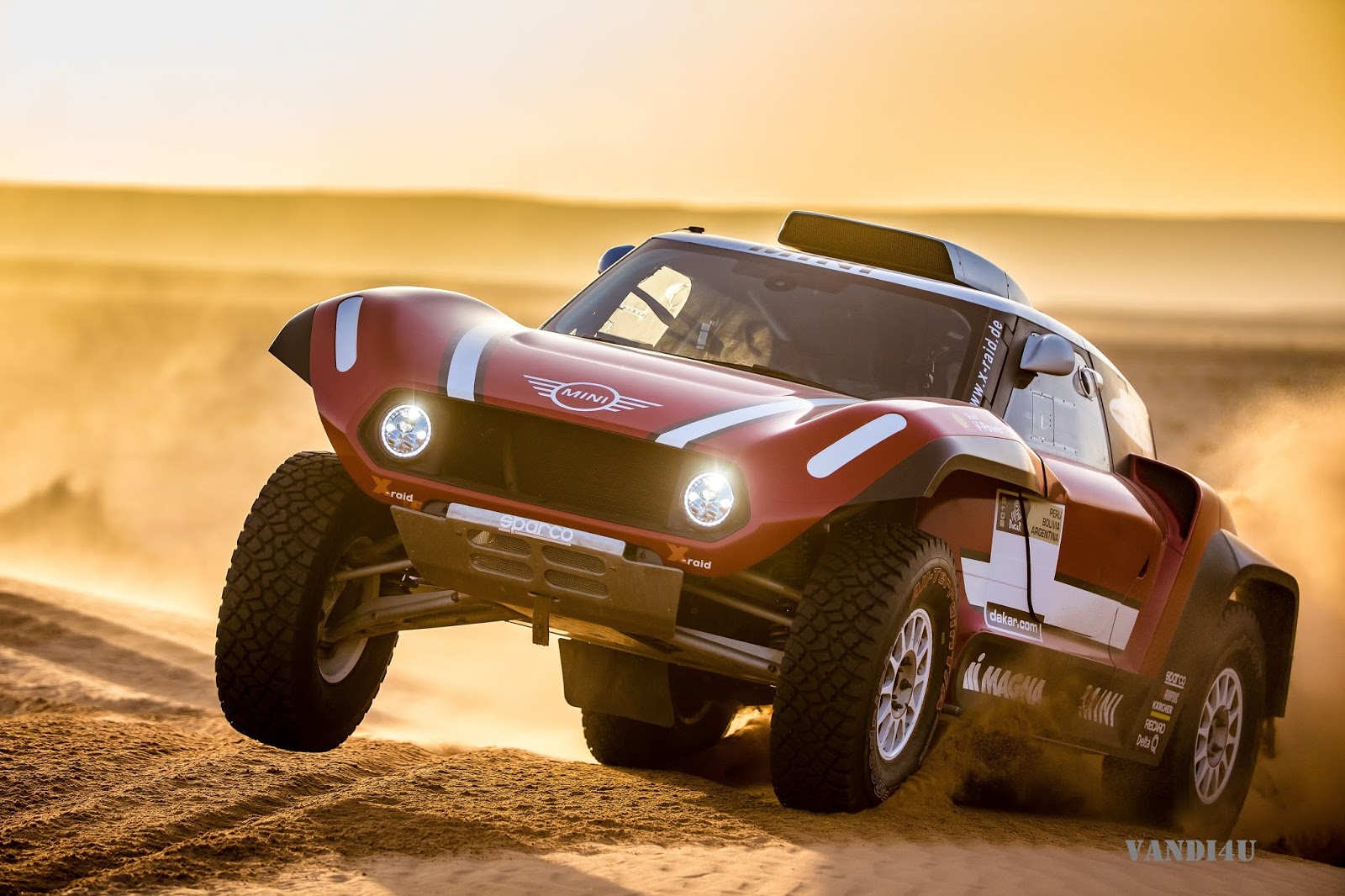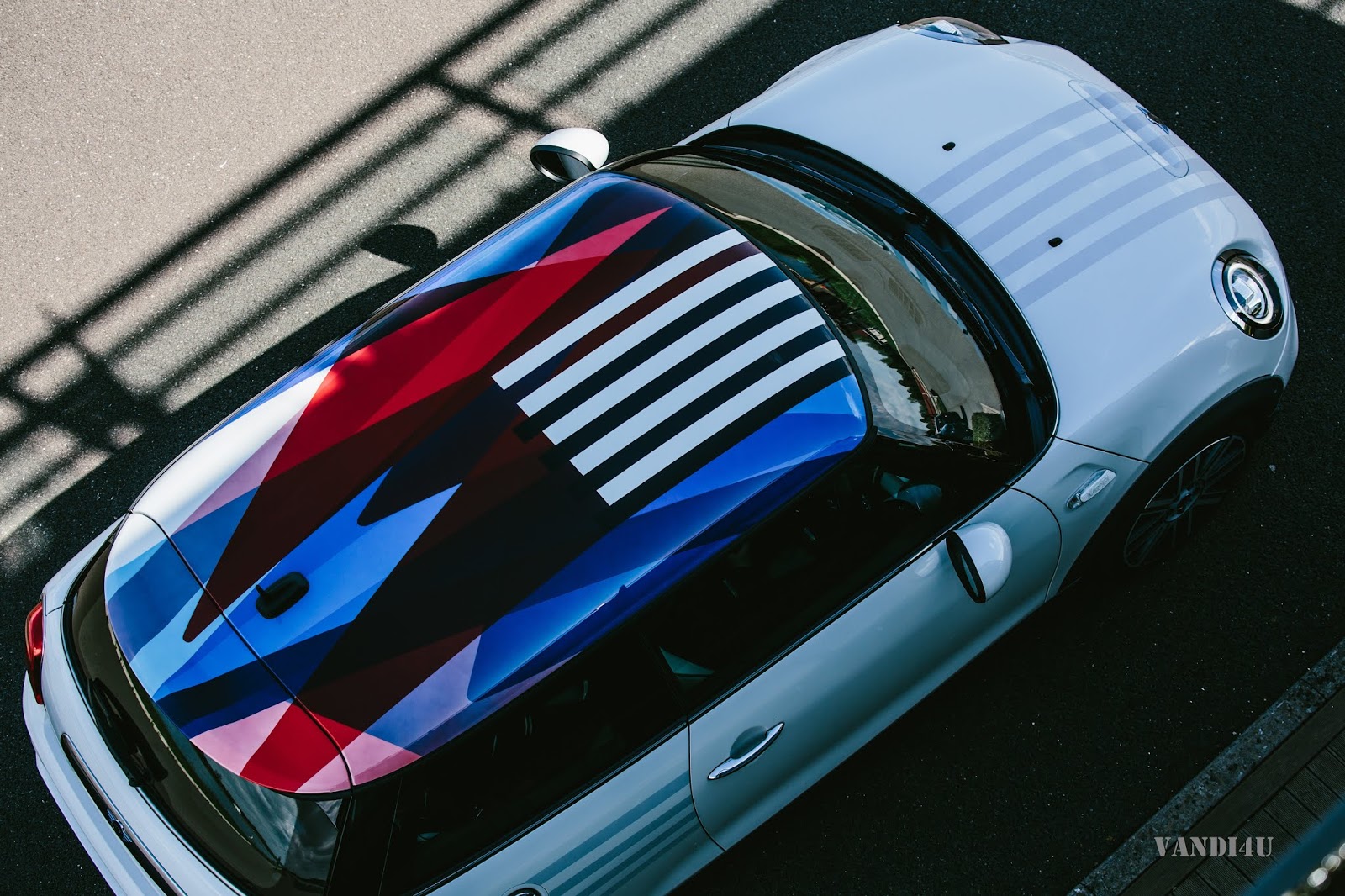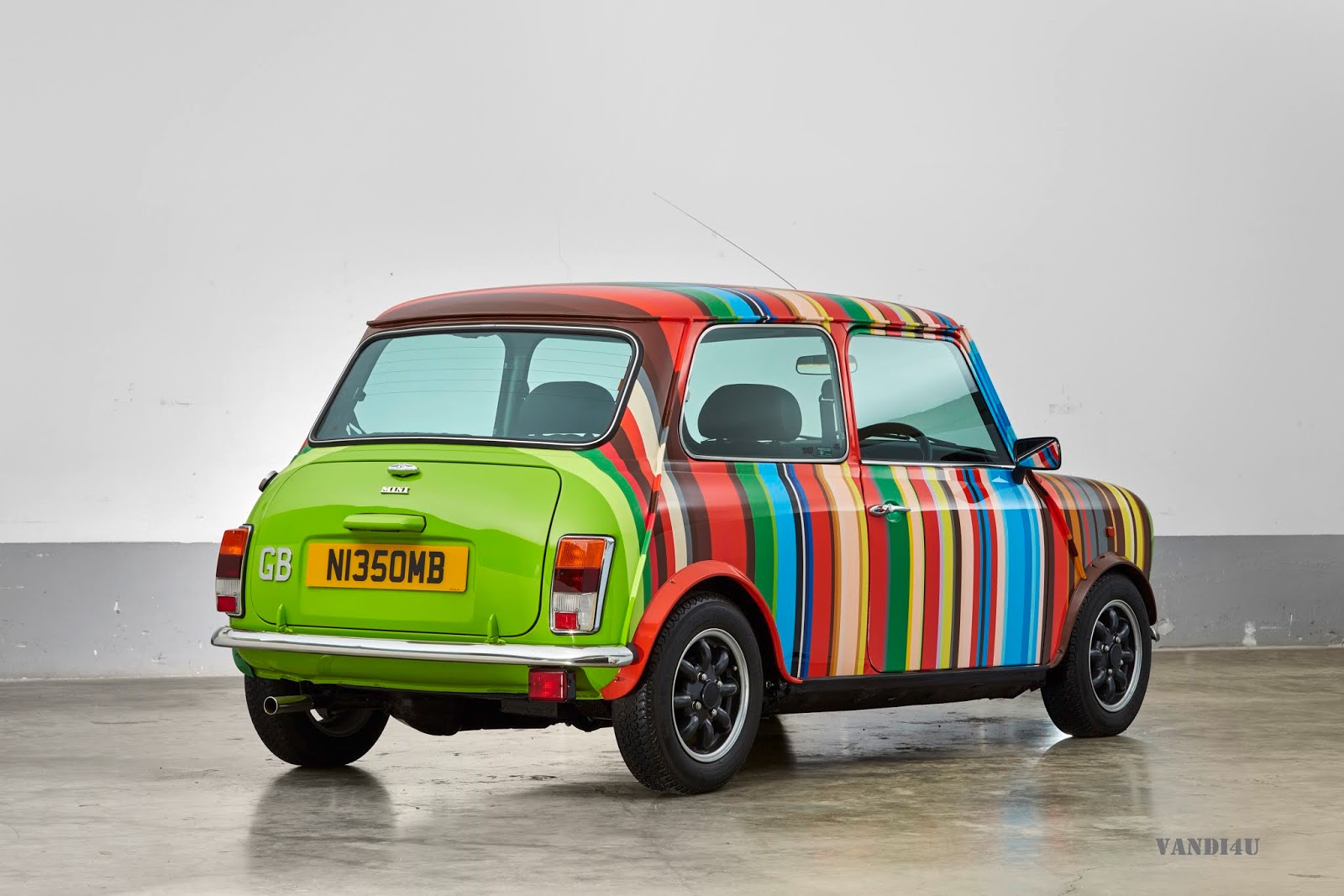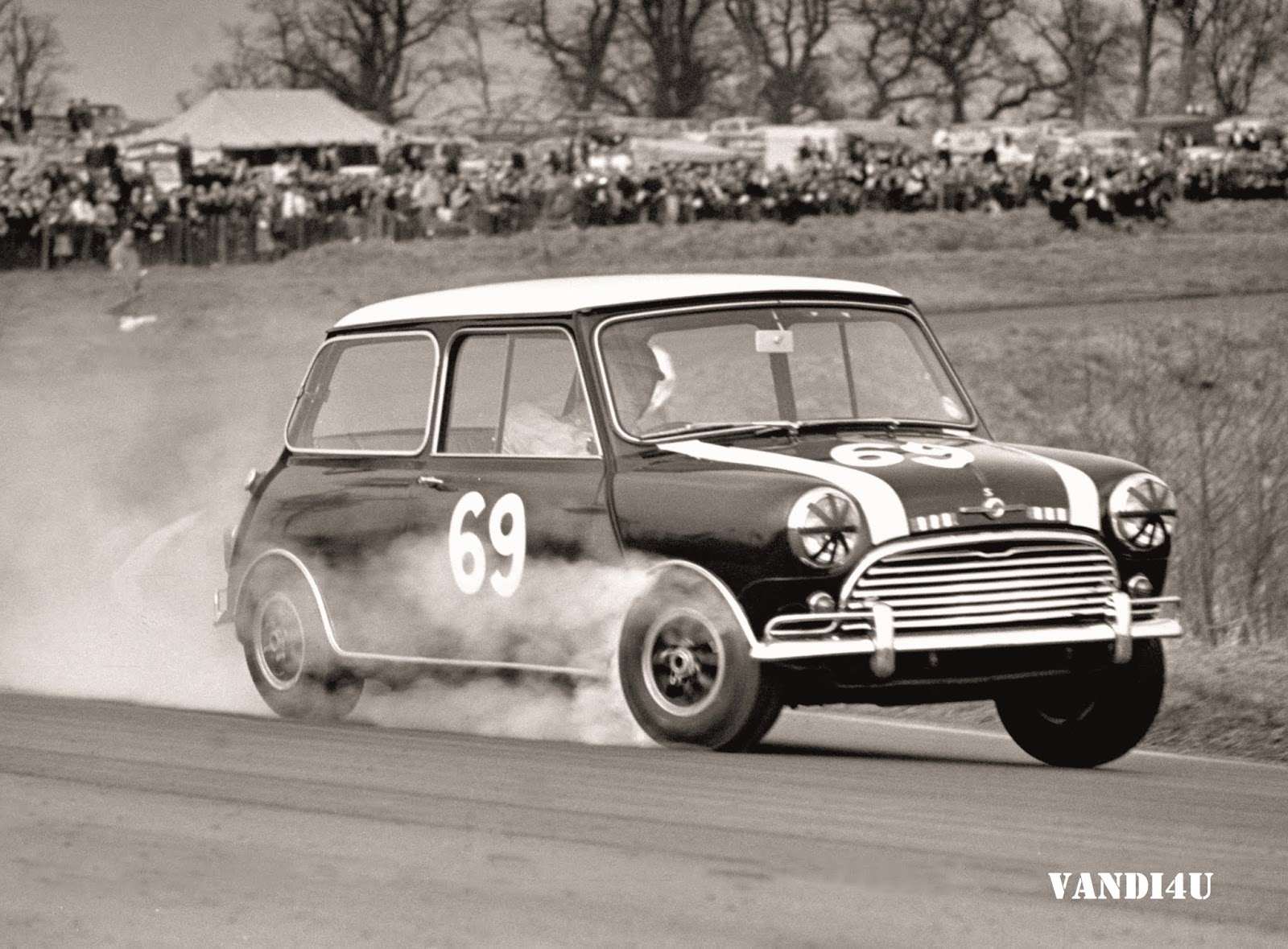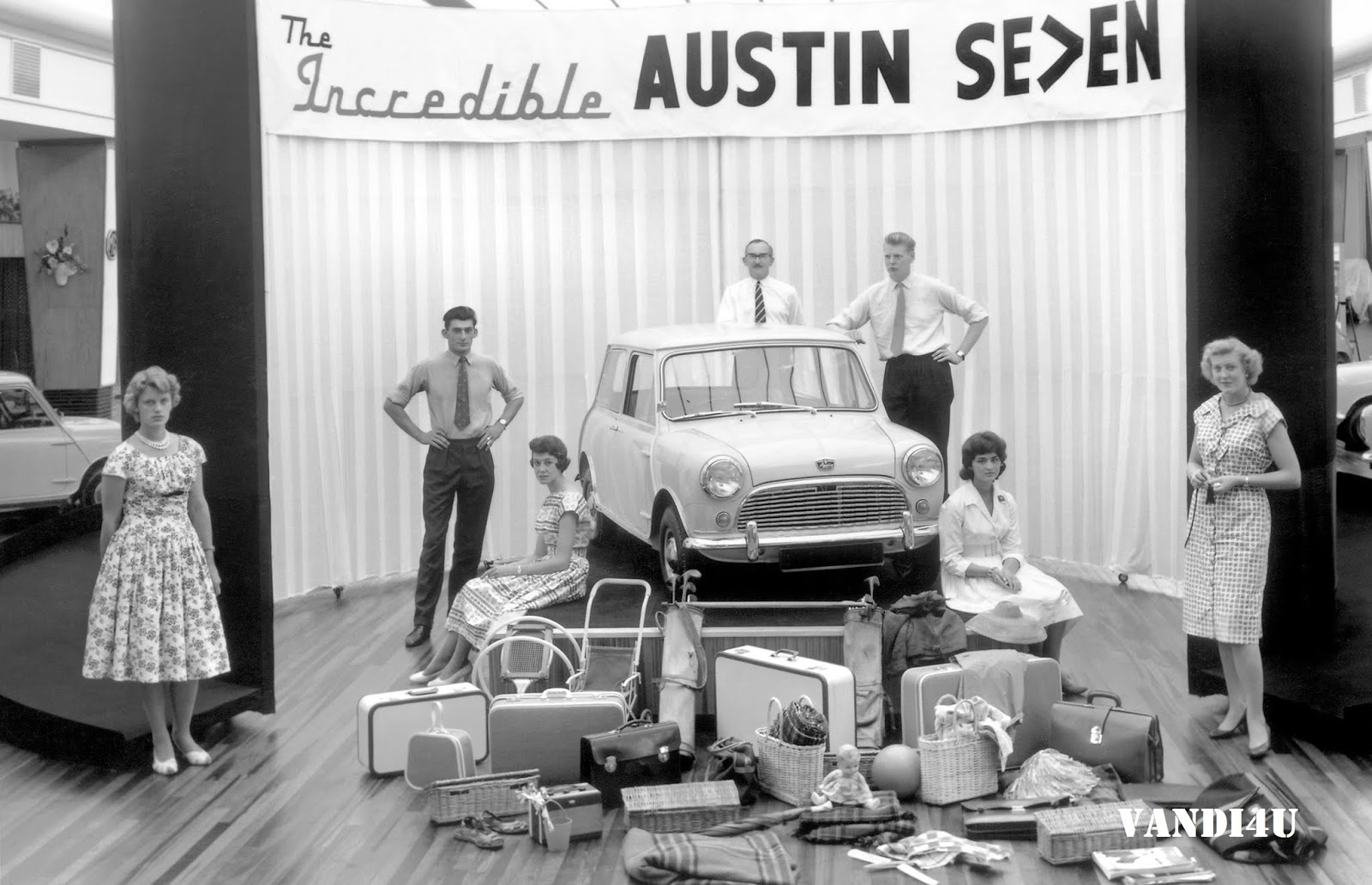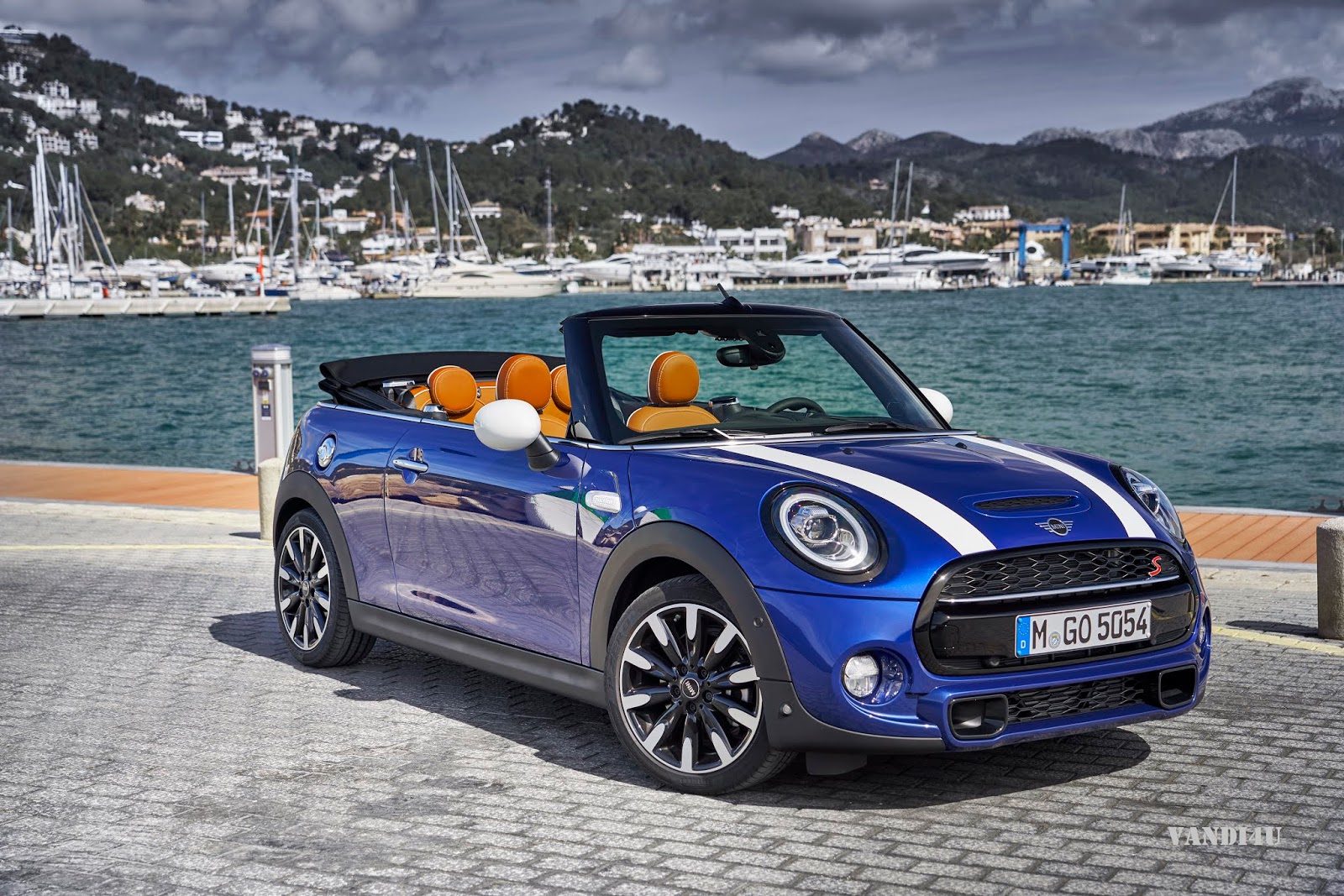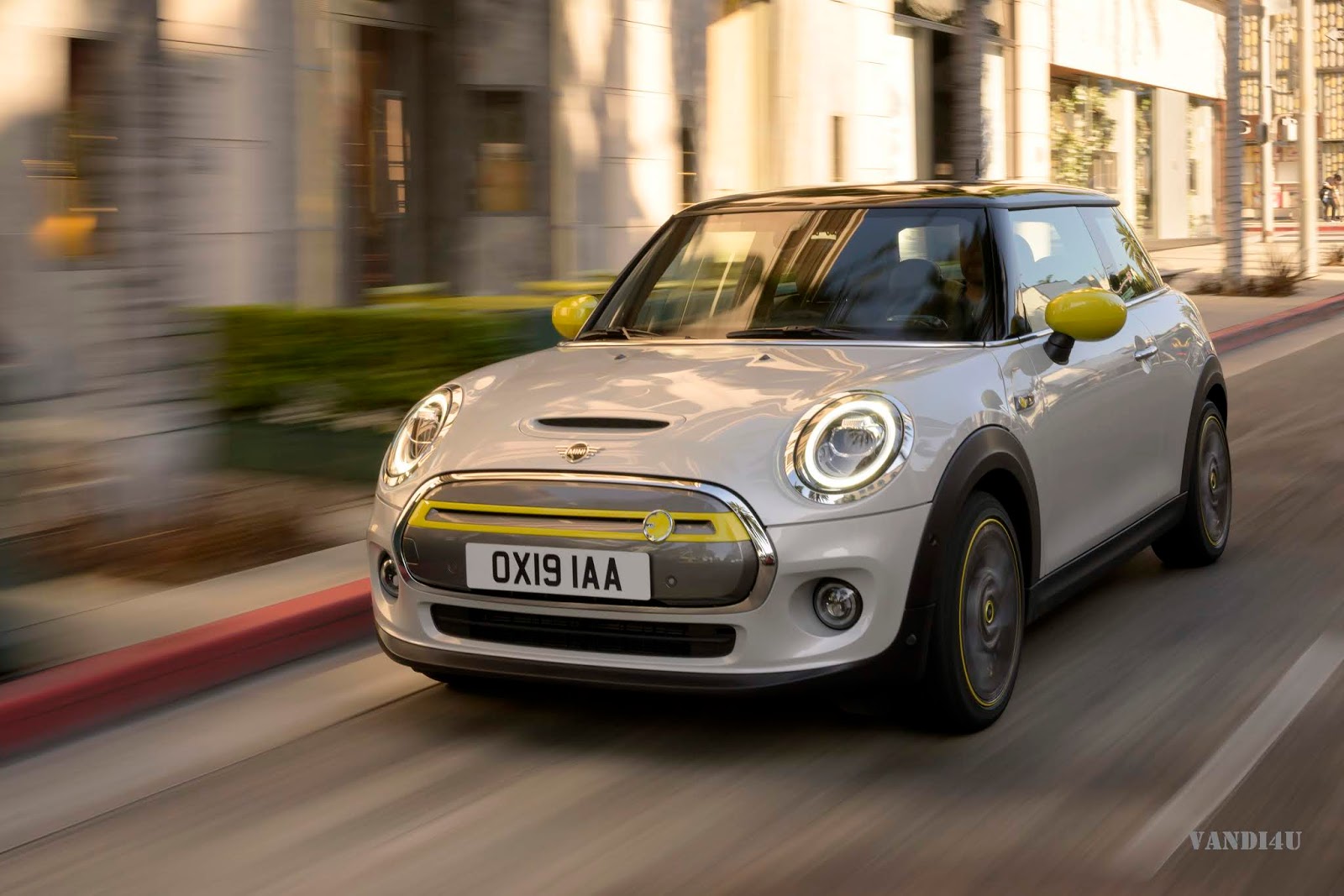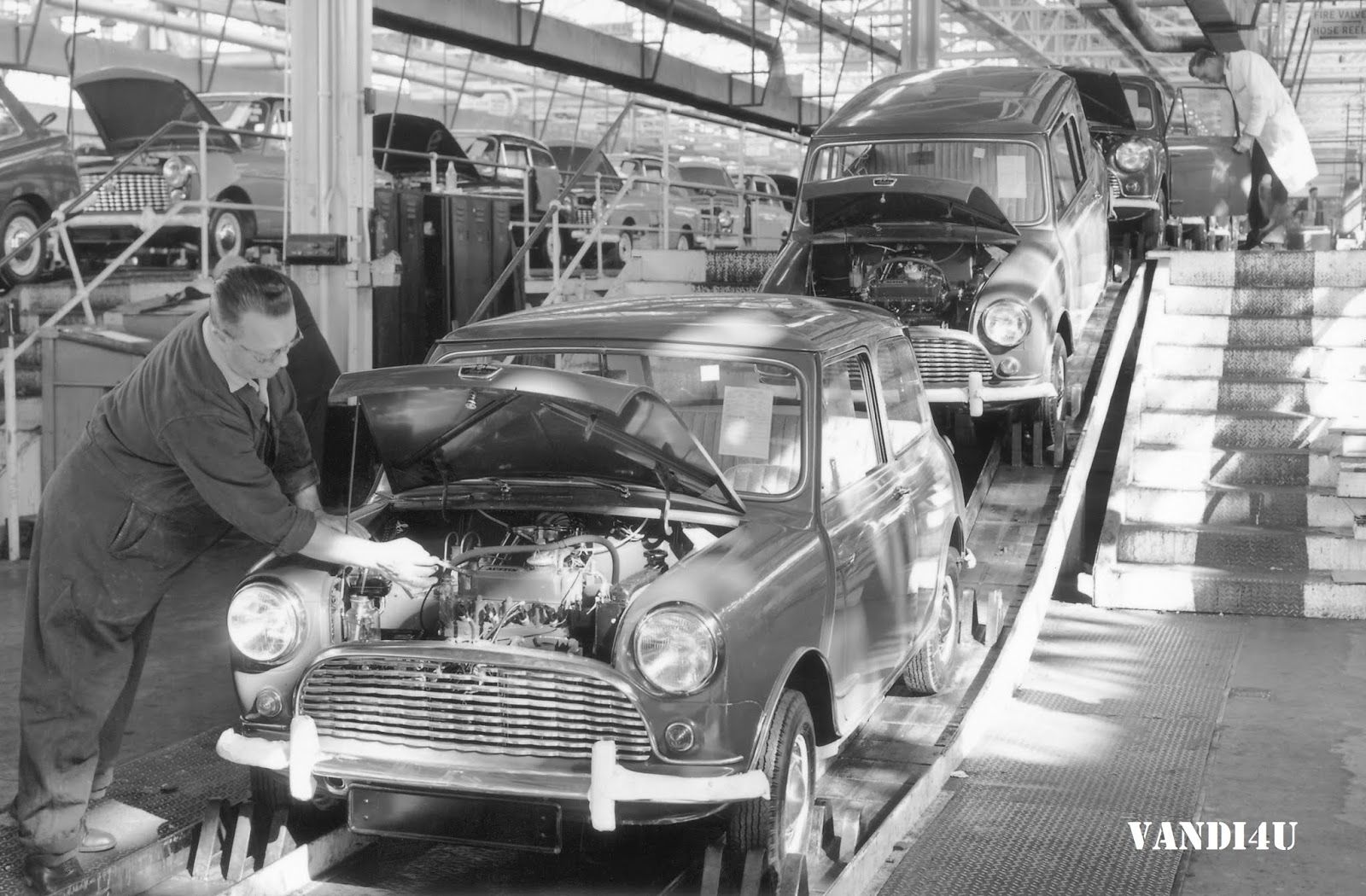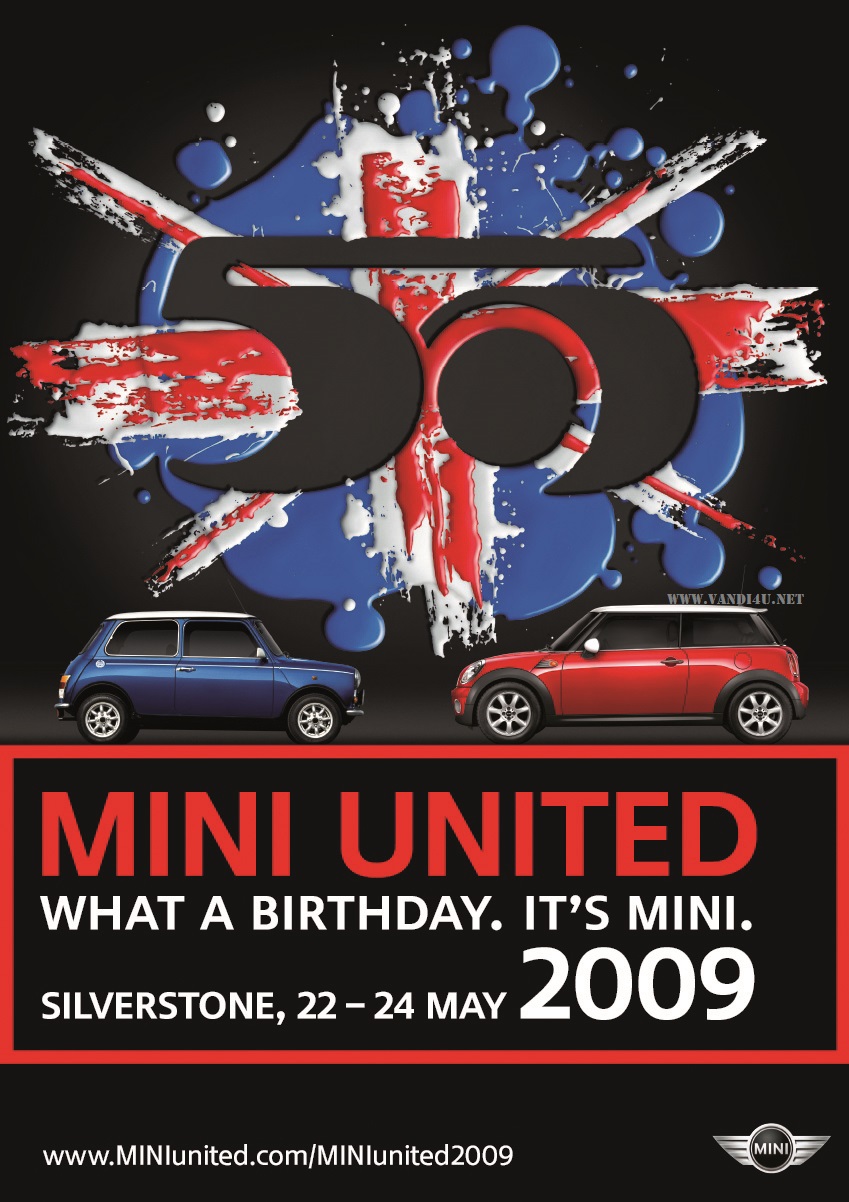The original in the premium segment of small cars has reached its 60th birthday – but it is even younger than ever. It was sixty years ago, to be precise on 26 August 1959, that British Motor Corporation (BMC) proudly revealed the result of their development activities in creating a new, revolutionary compact car.
Right from the start, the classic Mini was a member of high society: royalty, film stars, musicians and celebrities from the world of fashion succumbed to the charm of the British original. To mark the brand’s birthday, MINI presents a restored classic Mini in the striped design of the 60 Years Lifestyle Collection.
Lots of space inside with minimum dimensions outside, seats for four passengers, impeccable driving characteristics, superior fuel economy, and a very affordable price – precisely this was the brief the creator of the Mini, automotive engineer and designer Alec Issigonis, received from BMC’s Top Management. And the brilliant ideas he implemented in developing this two-door for a family of four had an impact quite sufficient for more than one single car, an impact therefore carried over successfully to other model variants.
 |
| Mini Estate |
Precisely this is why the Mini Van and Mini Estate also appeared on the market in the very first year of production of the classic Mini. And ever since the re-birth of the brand with the market launch of the MINI in 2001, the principle already applied successfully sixty years ago has once again proven its full value: a superior concept is always convincing in many different variants and renditions. Today, this still applies for the small cars MINI 3-door, MINI 5-door and MINI Convertible, for the MINI Clubman and the MINI Countryman in the premium compact segment, and soon for the all-electric powered MINI Cooper SE. They all show their individual strength and unique character, while right inside they are one and the same car in particular: a MINI.
One of the reasons for this outstanding success is that from the start the Mini met all the requirements of its time, while offering further qualities in the same process. Measuring just 3.05 metres or 120″ in length and selling at a retail price of £ 496, the Mini was simply perfect for small parking spaces and low budgets. Through its driving qualities and the charming character of its proportions alone, the Mini was however also of great interest to the ambitious motorist seeking not only compact dimensions and superior economy, but also sporting performance particularly in bends as well as individual style on the road.
This blend of different qualities remains as popular today as ever before, with a concept likewise younger than ever. Hence, the current MINI is also more up-to-date and, at the same time, more fascinating and respected than any of its competitors, combining unparalleled efficiency, lasting value of the highest calibre, and incredibly agile handling in the modern mega-city with unrivaled sportiness and design full of expression and quite unmistakable.
Longer, stronger, more sophisticated, more versatile: the first variants of the classic Mini.
 |
| Alec Issigonis with an Austin Seven |
Introducing the classic Mini, Alec Issigonis, the creator of this unique car, clearly fulfilled his mission. The Morris Mini-Minor and the Austin Seven, differing solely through their radiator grille, wheel caps and body colour, were both powered by a four-cylinder engine fitted crosswise at the front and delivering maximum output of 34 hp from 848 cubic centimetres.
The performance of both models was identical, as was their luggage capacity of 195 litres or 6.83 cubic feet at the rear. Everybody was thrilled by the generous space available, the efficient but powerful engines, the good roadholding and the comfortable suspension this new compact car had to offer. But Issigonis was already looking far into the future – and he was not the only one.
As early as in 1960, BMC added a Mini Van to the classic Mini. Then, proceeding from this van structure with its closed side panels, BMC introduced an Estate version with glass windows all round as well as two rear doors, like the Van.
 |
| Mini Pick-up |
Like the saloons, this body variant was also marketed as the Morris Mini-Traveller and the Austin Seven Countryman with exactly the same technical features. And at the latest in 1961 the potential of the classic Mini really became clear once and for all, the year starting with the introduction of the smallest of all transporters, the Mini Pick-Up. Just half a year later two other Minis, this time at the noble end of the scale, saw the light of day: the Wolseley Hornet and the Riley Elf.
Now, therefore, two further BMC brands were able to benefit from the concept of the classic Mini, both models proudly bearing their own distinguished look through their majestic radiator grilles, an extended luggage compartment and swallow-tail wings at the rear. A very special variant destined more than any other to create the legend of the classic Mini made its appearance in the second half of the year: the Mini Cooper. John Cooper, the famous engineer and manufacturer of sports cars already a close friend of Alec Issigonis, had recognised the sporting potential of this new small car right from the start, when the first prototypes appeared on the track. So he received the go-ahead from BMC’s top managers to develop a small series of 1,000 units of the Mini Cooper featuring a modified power unit enlarged in size to 1.0 litres and offering maximum output of 55 hp.
The response to this car entering the market in September 1961 was quite simply euphoric, with only one further request from enthusiasts everywhere: even more power! So Issigonis and Cooper enlarged engine capacity to 1,071 cc, raising engine output to 70 hp.
This made the Mini Cooper S a truly exceptional performer not only on the road, with Finnish driver’s Rauno Aaltonen’s class win in the 1963 Monte Carlo Rally marking the starting point for a truly unparalleled series of outstanding success in motorsport. The highlight, of course, was three overall wins in the Monte Carlo Rally in 1964, 1965, and 1967.
Versatility at its best: from the Mini Moke to the Mini Clubman.
 |
| Mini Moke |
In August 1964 BMC presented yet another version of the classic Mini originally conceived for military use: the Mini Moke, a four-seater open all round and destined to remain in the price list for four years.
The “bodyshell” of this unique car was made up, for all practical purposes, of the floorpan with wide, box-shaped side-sills, together with the engine compartment and windscreen. To the event of rainfall, a folding soft top appropriately referred to as a “ragtop” at least tried to provide certain protection. Using the drivetrain and technical features of the “regular” Mini, the Mini Moke became a genuine success particularly in sun-drenched parts of the USA and in Australia. By 1967 the time had come for a thorough update of the classic Mini, the car receiving a more powerful engine offering 38 hp from a larger capacity of 998 cc.
 |
| Mini Clubman |
Two years later the Mini Clubman joined the range as a slightly larger model with a somewhat different front end compared to the classic Mini. Indeed, this sister car was some 11 cm or 4.33″ longer than the original, the Estate version replacing the Morris Mini-Traveller and the Austin Seven Countryman measuring exactly 3.4 metres or 133.9″ in length, while width, height, and wheelbase remained unchanged. At the same time the Mini Cooper was taken out of production, being replaced by the top model in the Clubman range, the Mini 1275 GT developing 59 hp from its 1.3-litre power unit. A number of other details also changed in 1969, the front sliding windows so typical of the classic Mini since the beginning being replaced on all models by wind-down windows, the door hinges at the outside being moved to the inside, and a special “Mini” badge now standing out proudly on the engine compartment lid.
Never-ending classic Mini and the comeback of the Mini Cooper.
 |
| Mini Classic “Final Edition” |
Numerous special versions of the classic Mini with all kinds of highlights – from sporting to trendy, from distinguished to fresh – entered the market as of mid-1970. Between 1980 and 1983 the model range was streamlined appropriately, with the Clubman, Estate and Van leaving production. The “only” car left over, therefore, was the classic Mini with its 1.0-litre power unit now delivering 40 hp. And customers, simply loving the car, remained faithful to this little performer for years to come, the five-millionth classic Mini coming off the production line at Plant Longbridge in 1986.
In 1990 fans the world over were delighted to celebrate the comeback of the Mini Cooper once again entering the model range. Now this special model was powered in all cases by a 1.3-litre, production of the 1.0-litre in the Mini ending in 1992 on account of growing requirements in terms of emission management. So from now on all models came with the 1,275-cc power unit and fuel injection.
Yet another new variant of the classic Mini made its appearance in 1991 as the last new model in the range. And this was indeed the only Mini to originate not in Britain, but in Germany: Like some tuners before him, a dedicated Mini dealer in the German region of Baden had cut the roof off the classic Mini, turning the car into an extremely attractive Convertible. And contrary to earlier attempts, the result was so good this time in its quality that Rover Group, now responsible for the classic Mini, decided to buy the construction tools and production equipment for the Mini Convertible, which from 1993 to 1996 accounted for sales of approximately 1,000 units.
Production of the classic Mini finally ceased once and for all in the year 2000. In the course of time more than 5.3 million units of the world’s most successful compact car had left the production plants in numerous different versions, among them some 600,000 cars built at Plant Oxford between 1959 and 1968. But even after 41 years, there was still a long way to go. For after a break of not quite one year, a new chapter in the history of this world-famous British brand opened up in 2001.
A new start in 2001 – starring the MINI Cooper right from the beginning.
 |
| Mini ACV30 Concept Car |
Taking over Rover Group in early 1994, BMW also opened up new perspectives for the Mini brand. The first step was to present a concept version of the MINI Cooper at the 1997 Frankfurt Motor Show offering an outlook at the new interpretation of this unique small car from Great Britain. As a modern rendition of the Mini’s concept so rich in tradition, the new version for the first time combined the classic values of its predecessor with the demands made of a modern car set to enter the 21st century. The series production version of the MINI Cooper made its first official appearance in November 2000 at the Berlin Motor Show, the future-oriented interpretation of the original entering showrooms just a year later in the guise of the 85 kW/115 hp MINI Cooper and the 66 kW/90 hp MINI One. Featuring front-wheel drive, four-cylinder power units fitted crosswise at the front, short body overhangs and ample space for four, the new models successfully took up elementary features of the classic Mini. And while the exterior dimensions of the car were now larger, meeting modern requirements in terms of interior space, the design of the new model clearly retained the proportions so typical of the brand, as well as the unmistakable design icons at the front, the rear and at the side, thus boasting a clearly recognisable link between the MINI and its classical predecessors.
At the same time the MINI built in Oxford stood out clearly as the first premium car in the compact segment, achieving a status strongly reflected by a level of safety uniquely high for a car of this class as well as the uncompromising standard of quality so typical of BMW. The new MINI also set new standards through its surprisingly agile handling, immediately moving right up to the top in terms of driving pleasure. This meant that the new model followed in the footsteps of the classic Mini, but now with a lot more power and performance thanks to the most advanced and sophisticated drivetrain and suspension technology.
Ongoing success the world over – from 2004 also in the MINI Convertible.
Almost overnight, the new interpretation of this classic small car developed into a worldwide story of success continuing to this very day. The introduction of new engine variants, to mention such one significant highlight, served to offer additional momentum, the MINI Cooper S with its 120 kW/163 hp compressor engine entering the market as an exclusive driving machine in June 2002, the MINI One D just a year later setting new standards in terms of all-round economy and efficiency as the first diesel in the history of the brand.
The desire to drive a MINI in the open air, finally, also came true much faster than in the classic model, with the MINI Convertible making its debut in spring 2004. In the four years to follow, various versions of the convertible with its electrohydraulically operated soft roof were produced at the MINI Plant Oxford in the guise of the MINI Cooper S Convertible, the MINI Cooper Convertible, and the MINI One Convertible.
From the original to the original: the new edition of the MINI follows in 2006.
Showing tremendous success in the market, the MINI outperformed even the wildest expectations. Indeed, it quickly motivated the consistent continuation of this concept, taking up and fulfilling additional potentials as a new edition that continued many successful features and even made improvements to some areas.
Further enhanced in an evolutionary design process and thoroughly renewed in technical terms, this new MINI entered the market in November 2006. Following the motto “From the Original to the Original”, the design of the MINI already receiving the greatest praise everywhere was further refined in numerous details highlighting even more imperiously the sporting virtues of this compact and agile performer. So that now the looks of the car really conveyed a clear signal confirmed from the start by the driving experience.
New, even more powerful and, at the same time, far more efficient engines, together with the further enhanced suspension technology, served in this new generation to offer even greater driving pleasure so typical of MINI. Both the MINI Cooper S with its 128 kW/175 hp power unit and the 88 kW/120 hp MINI Cooper introduced from the start thrilled aficionados everywhere through their enhanced driving performance combined with significantly greater fuel economy and emission values.
Modern versatility: the MINI Clubman and the new MINI Convertible.
 |
| Mini Clubman |
Almost exactly one year to the day after the launch of the new model generation, the MINI model range was further enhanced by an innovative new concept in autumn 2007. The MINI Clubman offered a reinterpretation of the traditional shooting-brake concept with a body 24 centimetres longer, a streamlined, extended roof contour and a hatchback. The wheelbase extended by eight centimetres successfully expanded legroom in the front of the car. The driver’s and passenger’s doors in the MINI Clubman were supplemented by an additional entry on the right-hand side of the car and the two wings of the Splitdoor at the rear opening to the side. The two-part rear door takes up an authentic detail from the car’s classic predecessors – the Morris Mini-Traveller and the Austin Mini Countryman – back in the 1960s.
An even more sporty design, optimised active and passive safety, a wider range of functions and the latest generation of power units extended the model range by a new edition of the MINI Convertible in 2009. The opening and closing of the car’s fabric roof was now operated by an electrohydraulic mechanism – even while on the move at speeds up to 30 km/h – all within the space of just 15 seconds. The single-part rollbar also facilitated incorporation of a large through-loading space between the luggage compartment and the passenger compartment.
Advance into the premium compact segment.
On the brand’s 50th anniversary, preparations for the advance into another vehicle class were already well on the way. And in 2010, the MINI Countryman was launched with the aim of enthusing additional target groups with the brand’s driving fun and individual style – not simply on all the world’s roads but also beyond conventional carriageways. The new model for the premium compact segment was the first MINI ever to have a length of more than four metres, five seats, four doors plus a tailgate and optional all-wheel drive. The commanding front end and imposing new headlamp contours of the MINI Countryman defined individual accents. Thanks to the hexagonal radiator grille, the short overhangs, the high shoulder line and powerful stature, this vehicle was nevertheless immediately identifiable as absolute MINI.
The reinterpretation of classic features and virtues was continued in 2013 with the MINI Paceman. Dynamically extended coupé lines, two doors and a large tailgate provided the car with an extravagant appearance. The MINI Paceman was also supplied with optional ALL4 all-wheel drive.
The latest model generation: MINI reinvents itself anew.
 |
| Mini Countryman |
The beginning of 2014 heralded the latest generation change in the MINI model range. The current offering in the small-car premium segment comprised the MINI 3 Door, the MINI 5 Door also presented in 2014 and the MINI Convertible, the latest edition of which lined up at the beginning of 2016. The new model generation continued its global success story with another evolutionary development of advanced design, optimised functionality, further enhanced driving fun and a variety of innovations in the areas of control, driver assistance systems and connectivity. New three and four-cylinder engines with MINI TwinPower Turbo technology and an output range between 55 kW/75 hp and 141 kW/192 hp deliver a further optimised relation between driving fun and fuel consumption.
In the premium compact segment, the latest model generation of MINI also has two strong vehicle characters. The new edition of the MINI Clubman has mastered the leap into the higher car class with a definitively refined and mature vehicle concept. A significantly more spacious interior, four doors and five seats give the new MINI Clubman enhanced variability and allow it to meet aspirations beyond the urban traffic environment. The vehicle can also be optionally fitted with the ALL4 all-wheel power unit.
The new edition of the MINI Countryman is even more generous, more modern, more versatile and yet more sporty. The exterior length has increased by 20 centimetres compared with the predecessor model and its powerful proportions give the new allrounder a particularly independent profile. The latest generation of the ALL4 all-wheel drive can also be optionally fitted in the new MINI Countryman to provide offroad driving fun away from conventional roads. Like the MINI Clubman, a choice of six modern engines is also available for the MINI Countryman.
In addition, it paves the way for driving fun typical of the MINI brand with electric drive. The MINI Cooper S E Countryman ALL4 is the first model of the brand with a plug-in hybrid drive. A three-cylinder petrol engine drives the front wheels and an electric motor powers the rear wheels to yield intelligently managed interaction for highly efficient driving fun with optimised traction and drive stability.
With traditional sporting spirit and British flair.
The MINI 60 years edition.
An original that constantly reinvents itself – firmly rooted in tradition yet always open to change: this is MINI, 60 years after the launch of the small British car that brought worldwide popularity to unique properties such as go-kart feeling and the creative use of space. To mark this round anniversary, the premium automobile manufacturer presents a design model that highlights both its British origins and the agile MINI character. With design and equipment features that are both high-quality and exclusive, the MINI 60 Years Edition expresses the brand’s sporting spirit – something that is a constant presence even in everyday urban traffic. The special edition is supplied as a MINI 3 Door and MINI 5 Door, each with three engine variants.

Athletic talent is part and parcel of the MINI genes. Even before the launch of the classic Mini in the summer of 1959, it was clear that the design features of the new small car would benefit not just interior space but also the car’s agile driving properties. Sports car designer John Cooper was an especially strong believer in the compact four-seater’s race track potential. In collaboration with Alec Issigonis, the creator of the classic Mini, he developed ideas for variants of the small car with a more powerful engine, thereby laying the foundations for an exceptional career on racing circuits and rally tracks, culminating in three outright victories at the Monte Carlo Rally in the 1960s.
With a paint finish in the classic colour of British racing cars, the MINI 60 Years Edition in particular evokes the brand’s sporty career, which it started at a very early stage and has maintained up until the recent past. The exterior paint finish in British Racing Green offers a particularly clear expression of the premium small car’s character and origins. The body finishes Midnight Black metallic, Moonwalk Grey metallic, Melting Silver metallic and MINI Yours Lapisluxury Blue non-metallic are also available as alternatives. The chosen body colour is combined with a paint finish in Pepper White or Black for the roof and exterior mirror caps. Bonnet stripes with a specific anniversary design and exclusive 17-inch light alloy wheels in the version 60 Years Spoke 2-tone round off the distinct look of the edition vehicles.

The design model’s striking 60 Years logo appears not just on the left-hand bonnet stripe but also on the side scuttles of the turn indicators and on the door sill finishers at the driver and front passenger doors. Inside the car it can also be seen on the front headrests and the steering wheel. In addition, the exclusive design model has model-specific interior trim finishers. The anniversary design can also be seen in the LED logo projection which is visible when the driver’s door is opened. The standard equipment of the edition vehicles includes a sports leather steering wheel along with sports seats in the leather finish MINI Yours Leather Lounge 60 Years and the exclusive colour Dark Maroon.
In conjunction with the equipment package 60 Years Trim, the edition vehicles also feature such items as LED headlights, LED fog lamps, white turn indicators and LED rear lights in Union Jack design, the lighting package for the interior and also the MINI Driving Modes and the MINI Excitement Package complete with ambient lighting. There is also an on¬board computer, automatic air conditioning, a rain sensor and a storage package on board.
Three petrol engines and two diesel engines with an output ranging from 75 kW/102 hp to 141 kW/192 hp provide the drive portfolio for the MINI 60 Years Edition. The range of anniversary models includes the MINI One 60 Years Edition 3 Door and the MINI One 60 Years Edition 5 Door.
Motor sport meets Lifestyle.
MINI and the success story of motor sport.
It is in the car’s DNA and it was obviously there right from the start: the sporting talent of the classic Mini. When Alec Issigonis was requested by British Motor Corporation (BMC) in late 1956 to develop an economical but nevertheless fully-fledged small car with four seats, it quickly became clear that this new model would be truly innovative and, indeed, revolutionary in every respect. Front-wheel drive, extremely short body overhangs, a wide track, a low centre of gravity, optimum use of space and low weight were defined right from the start as elementary features of the new model.
Looking at the first drawings of the new car by his business partner and friend Alec Issigonis, sports car wizard John Cooper noticed yet another significant quality right from the beginning: He recognised that this ingenious concept for an economical compact car also provided the ideal starting point for a most promising sports model, setting out on the process of tuning the Mini even before the car had entered the market. This set the starting point for an unprecedented story of success in motorsport, closely connecting the name John Cooper with the sporting myth of the MINI to this very day. Outstanding victories in the Monte Carlo Rally are just as much part of this common history as the successful production cars proudly bearing the name Cooper.
Now integrated within the MINI organisation, John Cooper Works represents the epitome of supreme driving pleasure based on both well-founded know-how in motorsport and successful cooperation going back years and even decades. Apart from accessories for the drivetrain, suspension, streamlining, and design, the most athletic models in the product range each bear the brand logo symbolising extreme driving fun.
Racing pioneer John Cooper teaches Mini how to win.
Born in Surrey in 1923, John Cooper was one of the most outstanding celebrities in international motorsport – both as a driver and, even more so, as a constructor. Together with his father he established the Cooper Car Company in 1946, the two enthusiasts starting out with the construction of racing cars first for Formula 3, later also for Formula 1. Through their concept of a mid-engined sports car Charles and John Cooper set a truly revolutionary trend in the entire world of motorsport in 1955, Cooper racing cars winning both the Constructor’s and Driver’s titles in the World Formula 1 Championship in 1959 and 1960, for the first time in the history of motorsport with the engine mounted in the middle. And with this concept proving its success so convincingly, it is no surprise that soon all cars in Formula 1 came with a mid-mounted engine.
John Cooper and Alec Issigonis became close friends in the course of time after meeting and competing against one another at numerous races. There were also professional ties between the two enthusiasts, with the Cooper Car Company buying engines from BMC.
When it came to the Mini, however, the sporting ambitions of the two constructors were very different: Issigonis was looking above all at the right car for everyday motoring, Cooper was thrilled by the sporting potential of this small and nimble performer. So back in 1959, the very first year of the Mini, he sent his driver Roy Salvadori to Monza in the very first Mini Cooper, a special one-off model built specifically for this purpose. And indeed, this new sports car immediately proved its qualities on the way to Monza, Salvadori covering the distance more than an hour faster than his colleague Reg Parnell – who just happened to be driving an Aston Martin DB4.
Motivated by initial success in the 1960 Monte Carlo Rally, Cooper suggested building a GT model based on the Mini. And despite Issigonis’ rather sceptical opinion at least to begin with, George Harriman, the Chief Executive Officer of BMC, ultimately decided to build a small series of 1,000 Mini Coopers featuring a 55-hp power unit, that is 21 extra horsepower made possible by far-reaching modifications of the engine. The Mini Cooper’s top speed was approximately 130 km/h or 80 mph. The car’s transmission ratios were adjusted to the sporting potential of the engine and disc brakes on the front wheels ensured adequate stopping power.
Soon Issigonis was also thrilled by the results of these efforts. So joining forces with John Cooper, he quickly started working on the next engine upgrade, increasing engine bore to the ultimate limit on the Mini Cooper S: At 1,071 cc, engine capacity remained below the mark of 1,100 cc applicable in the particular class of motorsport seen as the target, with the engine revving up to impressive speeds. Maximum output was 70 hp at 6,200 rpm, maximum engine speed was 7,200 rpm. This version was again equipped with new brakes, braking power being boosted by a brake servo.
1964–1967: the golden years in the Monte Carlo Rally.

This set the basis for sensational success in motorsport, the Mini Cooper S hitting the headlines in Monte Carlo for the first time in 1962. With Finnish driver Rauno Aaltonen at the wheel, this small but highly nimble performer successfully left behind a whole pack of far more powerful Goliaths. But just three kilometres away from home, Aaltonen, leading the race at the time, misjudged a bend and finished the Rally with a rollover. Only a year later, however, Aaltonen made up for this misfortune, bringing home class victory in the Mini Cooper S and finishing third overall. But even more – and even better – was still to come: Entering the 1963/1964 rally winter, the Mini Cooper S was simply oozing power in comparison with its predecessor. So in a spectacular race, Paddy Hopkirk brought home first place overall in the Monte Carlo Rally, the small performer becoming a legend in motor sport virtually overnight. A year later Finnish racer Timo Mäkinen with his co-pilot Paul Easter repeated the same triumphant victory, reaching the finish line after thousands of kilometres as the only driver without one single penalty point – despite the worst weather imaginable. Indeed, only 35 out of 237 cars entered in the event were able to finish the Rally that year, among them no less than three Mini Cooper S.
Even so, the public were completely thrilled by the three Mini drivers, despite this questionable decision, Hopkirk, Aaltonen and Mäkinen therefore entering the annals of the Monte Carlo Rally as the “Three Musketeers”. And indeed, just one year later Rauno Aaltonen received truly overwhelming applause and acknowledgement when bringing home the third overall victory of the Mini Cooper S in the Monte Carlo Rally. Especially because this time there were no complaints about his car.
Legendary racing careers started at the wheel of a Mini.
The Mini was however highly successful not only in rally racing, but also on road circuits, bringing home numerous wins in the 1960s. Indeed, through its long list of successes in motorsport, the Mini became the most outstanding racing car of the entire decade. A particularly interesting point is that many spectacular racing careers started at the wheel of a Mini, a certain racing driver from Austria called Nikolaus Andreas Lauda entering his first hill-climb race at the wheel of a classic Mini near the Austrian town of Linz in April 1968, and immediately finishing second. Only two weeks later Lauda again confirmed his talent when scoring his first racing victory in a career which would take him on to three Formula 1 World Championships. And just like Niki Lauda, Formula 1 Champions Graham Hill, Jackie Stewart, John Surtees, Jochen Rindt, and James Hunt all gained their first racing experience in a classic Mini.
The world’s toughest rally: MINI with four back-to-back victories in the Dakar Rally.
MINI has now become firmly established in international rally sport. Spectacular performances by the MINI John Cooper Works WRC developed on the basis of the MINI Countryman in selected rounds of the FIA World Rally Championship (WRC) enabled the brand to continue its success story in rally sport during 2011 and 2012. The MINI ALL4 Racing was designed specifically for marathon rallies and this took up a further particularly special sporting challenge. In 2012, MINI and motor-sport partner X-raid entered the Dakar Rally, the ultimate endurance test for drivers, vehicles and teams. The performance and reliability of the MINI ALL4 Racing resulted in back-to-back Dakar victories in the years 2012, 2013, 2014 and 2015. In 2016, MINI won the category of All-wheel Drive Vehicles in this rally.

MINI also demonstrated in the FIA Cross-Country Rally World Cup how one success leads to another. The first win in the World Cup 2012 was repeated in three successive years (2013 – 2015). In 2017, the new MINI John Cooper Works Rally participated for the first time in this competition and in the Dakar Rally. In 2018, it won a further title in the FIA Cross Country Rally World Cup.
John Cooper Works – the epitome for extreme driving pleasure in the MINI.
John Cooper Works guarantee outstanding performance not only on the race track, but also on the road. Even back in the 1970s, John Cooper Works Tuning Kits for production versions of the Mini were very popular and even back then the classic Mini equipped with such special features and components was able to show its most outstanding virtues both visually and in technical terms. The same applies to the tuning kits for the MINI Cooper S and the MINI Cooper successfully introduced after the re-launch of the brand and available in the market under the label of John Cooper Works. The current range of John Cooper Works accessories comprises lightweight alloy wheels, ventilated brake disks, integrated tailpipes and other retrofit products for the exterior and the interior in the appropriate selection for each model.
MINI all the way – always different.
Customize to your personal taste.
Driving a MINI is not just a matter of getting from A to B, but rather an expression of your own personal style. And indeed, the many options to customise the MINI give the enthusiast a wide range of opportunities in bringing out his – or her – personal taste and preferences. Offering a wider range of features and highlights and going into greater detail than any other manufacturer of small and compact cars, MINI gives the customer the freedom to bring out his or her individual style and choice on the car, an exceptionally wide range of exterior and interior colours, seat upholstery and trim variants setting the foundation for a personal configuration tailored to the driver. A further point is that all the current MINI models are available with numerous highly attractive and sophisticated options straight from the plant, again enhancing both driving pleasure and motoring comfort.
Individualisation at the highest level: MINI Yours.
The options from the MINI Yours range pave the way for the most exclusive route to selective individualisation. High-quality materials, stylish design and precise processing to the very highest standards characterise these factory-supplied items of special equipment for the exterior and interior of current MINI models. They are unique individual options and are available in equipment packages put together specifically for each model.

The current MINI Yours range for individualising the exterior comprises exceptionally sophisticated paintwork options and impactful, athletic, elegant light-alloy wheel rims in a model-specific selection. The MINI Convertible also features a MINI Yours roof with a woven Union Jack. Personal style and a connoisseur’s sense of superlative quality are achieved with the MINI Yours packages for the interior. The MINI Yours Leather Lounge sport seats are upholstered and handcrafted in luxury smooth leather. Perforation technology integrates the classic Union Jack motif in the headrests. The MINI Yours Interior Styles are tailored to match specific models and comprise backlit surfaces, with light spots varying the colour to suit the ambient light conditions. Visible and tangible exclusivity also characterise the MINI Yours sports leather steering wheel finished in luxury soft nappa leather, the anthracite seams and spokes in high-gloss Piano Black. The individually styled products are supplied within a few weeks. They are designed so they can then be integrated in the vehicle by customers themselves or by participating MINI service partners.
Traditional values and modern diversity.
Concept and technology.

The economical compact car has a great future! Precisely this was the fundamental idea and philosophy in developing the classic Mini. The objective was to combine compact exterior dimensions and generous spaciousness within the interior, comfortable and sporting driving behaviour as well as fuel-efficient power units likewise characterising the new extra-small model from British Motor Corporation (BMC). It was the Suez Crisis in 1956 leading to severe cut-backs in oil supply that prompted BMC to assign automotive engineer and constructor Alec Issigonis with this challenging task. Today, on the other hand, the quest for efficiency has become a general need in public life, this compact car from Great Britain again offering the most convincing answer to this challenge. 60 years ago, the revolutionary design principle of the classic Mini created the foundation for maximum interior space on a minimal footprint. The modern reinterpretation for creative use of space and unsurpassed driving fun made the MINI the original in the premium segment of small cars when it was launched in 2001. Today, the MINI brand is the epitome of scintillating driving in the urban traffic environment and beyond. In future, the brand will combine electromobility and a unique emotional experience with the new MINI Cooper SE. It is based on the MINI 3 Door and combines local zero-emission driving with premium quality and striking design.
The birth of that go-kart experience.
Alec Issigonis and his team also took a new approach in the transmission of power, that is on the drivetrain. Since the propeller shafts used up to that time tended to deflect out of line under major steering lock, Issigonis decided to use homokinetic joints for the first time in an automobile. These joints were made up of a ball bearing surrounded by three cages, two of which were connected, respectively, with the incoming and outgoing drive shafts. This, in turn, allowed a sufficient steering angle without distortion or undue articulation, significantly reducing the effect of drive forces on the steering. And this, in turn, set the foundation for the go-kart feeling of the legendary Mini to this very day.
The latest generation: Even more driving fun, efficiency and premium quality.

In 2014, the current generation of the MINI lined up at the start with a renewed evolutionary and advanced design, new drive technology and a large number of innovative equipment features. Engines with MINI TwinPower turbo technology and also a newly developed gearbox have since then increased the sprint capability of the MINI while at the same time resulting in reduced fuel consumption. Depending on the engine, the standard 6-speed gearbox can be replaced by a 7-speed Steptronic gearbox with twin clutch or an 8-speed Steptronic gearbox. An additional enhancement to efficiency is provided by the optimised weight and the improved aerodynamic characteristics. The option of an adaptive suspension is available for the first time. MINI Driving Modes is a choice available for the first time in the new MINI. Adaptive suspension influences the characteristic curves for the accelerator pedal and steering characteristics as well as the shifting characteristics of the automatic transmission and the damper tuning. The new operating concept comprises an instrument cluster on the steering column and optionally a MINI head-up display. The collision and pedestrian warning with city braking function, the driving assistant and parking assistant, and the reversing camera significantly expand the choice of driver assistance systems. Once again, the MINI also takes a leading role among competitors in the area of networking technology and digital services.
From the Original to the Original.
The MINI Design.
Innovative, unmistakable, stylish – and inspiring time and again. Just like the classic Mini, the MINI stands for unique design providing brand-new answers to the challenges of its time. Creating the classic Mini, constructor Alec Issigonis and his team had succeeded in re-defining the entire philosophy of the small and compact car in 1959. Developing the MINI, his successors, as it were, re-interpreted the concept of maximum interior space on minimum road surface in modern, up-to-date style.
The MINI family grows: introduction of the MINI Clubman.
The 2007 Frankfurt Motor Show marked the world debut of the MINI Clubman which has been enriching the model family ever since. Compared directly with the MINI, the MINI Clubman offers 24 centimetres or 9.45″ more body length and 8 centimetres or 3.15″ longer wheelbase serving entirely to enhance legroom at the rear.
On the MINI Clubman the driver’s and front passenger’s doors are supplemented not just by the Splitdoor at the rear, but also by an additional opening on the right side of the car. This additional door on the right, the Clubdoor opening against the direction of travel like a coach door, offers passengers sitting on the rear seats of the MINI Clubman comfortable and convenient access to the rear passenger area. In its side view the MINI Clubman is characterised by a dynamic wedge shape created through the interplay of the shoulder line rising up slightly to the rear and the horizontal roofline.
MINI Convertible: consistently open, MINI all the way.

The open-air model of the brand is a genuine MINI but at the same time a truly unique character. The first new MINI Convertible was presented at the 2004 Geneva Motor Show three years after the closed MINI, but naturally with the same unmistakable design features. Apart from the soft roof combining the proportions typical of MINI when closed with a unique silhouette, the four-seater boasted a number of other features typical of a genuine Convertible. The waistline rising towards the end of the car, for example, was accentuated from the start by a chrome bar all round the vehicle, the steep windscreen was just as characteristic as the chrome-plated rollbar. And at the rear the boot lid opening downwards as well as the hinges at the outside offered further features reminiscent in their design of the classic Mini. The latest edition of the MINI Convertible experienced its first summer in 2016. 18 seconds suffice to combine the further enhanced driving fun in a MINI with the intense open-air feeling. This is facilitated in the new MINI by a fully-automated mechanism for opening the roof that is all-electric for the first time making it particularly low noise. There is now also a fully integrated rollbar.
Typically MINI – also in the premium compact segment.
Just as classical design features were transferred to a modern vehicle concept tailored to the requirements of the 21st century, the design so typical of the brand was also mapped onto the models of the premium compact segment. In 2010, the first MINI was presented with an exterior length of more than four metres, five doors and five seats. The MINI Countryman conquered new target groups across the world – with its unambiguous augmentation of versatility and the inimitable style of its design, making it a typical representative of the heritage British brand at first glance.
In the latest model generation, the MINI Clubman and the new edition of the MINI Countryman bring style typical of the brand into the premium compact segment. Reinterpreted and carefully enhanced, they also include typical MINI proportions, the characteristic three-way split between bodywork, window graphics and roof, the powerful stature underpinned by the wheels, and the unique details including the side scuttles, a large number of chrome elements, the hexagonal radiator grille and the large headlamps.
Dawn of a new era: The MINI Cooper SE.
As the first premium small car with all-electric drive, the new MINI Cooper SE also defines benchmarks for driving fun geared to the future in its design. It is based on the MINI 3 Door and differs from this with selective modifications and subtle differentiations from the conventionally powered models of the brand.
Powerful proportions, the horizontal vehicle structure, short overhangs and wheels positioned at the corners of the car characterise the appearance of the MINI Cooper SE. Precisely defined accents point to its future-proof drive system. The charging connection is positioned above the right-hand rear wheel and this is precisely where the tank nozzle is situated in the conventionally powered MINI 3 Door. An embossed MINI Electric Logo points to the difference in energy supply. Yellow versions of this logo also embellish the familiar side scuttles for the side indicators, the tailgate and the radiator grille. The central element of the vehicle’s front profile highlights the brand-typical hexagonal contour in the MINI Cooper SE, although it is shrouded owing to the low requirement of the electric motor for cooling air. A yellow trim bar on the grille and the wing-mirror caps finished in the same colour complete the model-specific design.
In the same way as the model-specific front grille, the essentially closed floorpan and the independent design of the rear apron contribute to the reduction of air resistance. The fact that the electrically powered MINI does not require an exhaust system, favours airflow in the floorpan and at the rear. An aerodynamically optimised surface is also highlighted by the optional 17-inch alloy wheels with an asymmetric design in the version MINI Electric Corona Spoke 2 Tone.
Made in England – then and now.
MINI Production between past And future.
The first Mini was an Austin Seven coming off the production line in Austin’s Longbridge Plant in Birmingham on 4 April 1959. The team of twins was subsequently completed five weeks later, the first Morris Mini-Minor leaving the Morris Plant in Oxford on 8 May. The two models were presented to the public together for the first time on 26 August 1959. Despite their different origin, the Austin Seven and the Morris Mini-Minor were virtually identical, the only distinctions on the outside being their radiator grilles, the wheel caps and body colours: The Austin Seven was available in Tartan Red, Speedwell Blue, and Farina Grey, the Morris Mini-Minor came in Cherry Red, Clipper Blue, and Old English White.
Production at the two plants continued for ten years with the model built in Longbridge bearing the name Austin Mini as of 1962. Plant Oxford, which had been building cars since 1913, built exactly 602, 817 units during this period, all of them the basic version of the four-seater. All other model variants ranging from the Mini Van through the Mini Pick-Up all the way to the Morris Mini-Traveller and Austin Seven Countryman were built in Longbridge. In 1969 all production activities were concentrated at the Longbridge Plant, with the model range being streamlined and Mini becoming the brand name for this revolutionary compact car. So the days of the twin brothers (or sisters?) were over once and for all.
A million cars in six years: the MINI repeats the rapid start of the classic Mini.
With the brand being re-positioned in 2001 under the guidance of the
BMW Group and production of the modern MINI starting as planned, it was only obvious that MINI had to move back to Oxford, the plant so rich in tradition thus once again becoming the starting point for a genuine revolution in the small car market. And like the classic Mini, the MINI made a remarkable start into the market exceeding all expectations: within just six years, Plant Oxford built no less than a million units of the MINI. This was indeed just as long as the classic Mini had taken to exceed the one-million mark, but back then production was still at two plants.
After 41 years and a production volume of more than 5.3 million units, the last classic Mini left Plant Longbridge on 4 October 2000. Since the decision to build the modern MINI in Oxford had already been taken half a year before, only nine months remained from then on to the start of MINI pre-production and just 13 months to the start of actual series production. Clearly, therefore, the roughly 2,500 employees in Oxford at the time and their colleagues from BMW Plant Regensburg supporting the modernisation process faced a great challenge and a truly tight timetable in making this new start into the market.
Team work for premium quality: The MINI Production Triangle.
When production of the new edition of the MINI was launched in autumn of 2006, the production facilities in Oxford (Bodyshop, Paintshop and Assembly), Swindon (Pressings) and Hams Hall (Engine Production) were integrated in the MINI Production Triangle for the first time. Body panels have been produced in Swindon, some 70 kilometres west of Oxford, since 1954. Today, pre-assembled body components such as lids and doors for the MINI Bodyshop are manufactured at Plant Oxford. Since 2001, the plant at Hams Hall near Birmingham has been the BMW Group’s Competence Centre for the production of four-cylinder petrol engines with a capacity of up to 2.0 litres. The plant delivers petrol engines directly to Oxford – just in time and just in sequence, that is at exactly the right time and in the right sequence for final assembly.
After 60 years: Ten million MINIs produced.
Capacity that started in 2001 as 300 vehicles manufactured each day has now increased to production output of around 1 000 units per day. Every 67 seconds, a workforce of 4 500 employees manufactures a MINI – each one of them is an ambassador for its idea, its country and its zest for life. In 2019, 60 years of the brand’s existence was celebrated in Oxford alongside a landmark production anniversary. The ten millionth vehicle of the brand rolled off the assembly line at the traditional site with an illustrious heritage: a MINI 3 Door from the 60 Years Edition.
Since 2000, the BMW Group has invested more than two billion pounds sterling in its production facilities in the United Kingdom. Recently, final assembly was expanded at the MINI Plant Oxford and a new paintshop was built. The latest investments have been channelled into the MINI Cooper SE. From November 2019, the first all-electric powered model manufactured by the brand will be produced at the MINI Plant Oxford.
Global growth strategy: Expansion of production capacities.
The models MINI 3 Door, MINI 5 Door and MINI Clubman are currently being produced at the MINI Plant Oxford. In order to take account of the continuous increase in demand, the BMW Group reached a decision in 2014 on contracted-out production of MINI models at the contract producer VDL Nedcar based in Born, Netherlands. MINI is therefore the only automaker to have series vehicles produced under contract manufacture in the Netherlands. The BMW Group benefits from the logistically advantageous location of the VDL Nedcar plant in the Born and its proximity to the British production triangle with locations in Oxford, Swindon and Hams Hall. The MINI Convertible and MINI Countryman models currently roll off the assembly line in Born.
In addition, the BMW Group and Chinese automobile manufacturer Great Wall concluded a joint-venture agreement in 2018. This covers a number of areas including the production of all-electric powered MINI vehicles for the Chinese market. A joint manufacturing facility is also scheduled for construction in the Chinese province of Jiangsu.
Individualists united!
MINI fans are networked worldwide.
 |
| International MINI meeting 2019 in Bristol (UK) |
An active and truly versatile fan community all around the classic Mini was already established in the United Kingdom Great Britain, the home country of the classic Mini, way back in the 1960s. Right from the start, fans expressed their common interest in the car and the brand by exchanging knowledge and experience all about the Mini and its technical features. Due to the charming character of this small compact car, owners of a classic Mini strongly identified right from the start with both their car and the brand, sharing this enthusiasm in joint drive-aways and regular Mini meetings, with clubs originally organised on a local basis spreading wider and wider to bring together large regions.
A dynamic club scene also developed quite early on in Germany, gaining additional momentum through the re-launch of the brand and the introduction of the MINI. In the meantime, thousands of members are organised throughout Germany in more than 100 classic Mini communities and more than 50 MINI Clubs. Through their wide range of activities, these enthusiasts act as authentic ambassadors of the brand and competent partners for new fans of both the classic Mini and the MINI. Furthermore, MINI enthusiasts joined together to share activities in lots of other countries. The international MINI Community is a phenomenon without parallel in the world of the automobile. MINI owners are individualists and this is reflected in the styling and equipment of their vehicles geared to personal style. At the same time, they have much in common and this is expressed in exceptionally communicative engagement with each other and in enthusiasm for technology, motor sport, lifestyle and design.
MINI enthusiasts come together – online and in the street.
The Community became increasingly international with the general spread of modern means of communication. Upon the introduction of the MINI into the market in 2001, the brand was positioned with the same standard philosophy and spirit for the first time worldwide in all relevant markets. Above all, use of the internet had enhanced the options to interact across national borders and continents. Members of national MINI online communities foster contact with similar clubs throughout the world on the World Wide Web.
As in the past, real-life meetings which, thanks to the use of many communication channels and the support of MINI have taken on impressive dimensions, are naturally still among the highlights of all activities. In 2005, for example, MINI Germany, together with the national classic Mini and MINI Clubs, organised the first national meeting in Germany for fans of the brand. Back then more than 2,500 participants travelled to the National Meeting, heading for the Loreley Plateau on the River Rhine, where they enjoyed a highly entertaining programme with MINI Driver Training, a Design Workshop, meetings with Mike Cooper and rally legend Rauno Aaltonen, as well as the presentation of new versions of the MINI. A second meeting at the Hildesheim Aerodrome in 2008 proved even more successful, at least in terms of participation, with twice as many MINI enthusiasts from all over Germany attending the event.
The national and international activities in the British club scene are even more spectacular. In 1999, for example, more than 50,000 visitors attended the International Meeting in Goodwood celebrating the 40th birthday of the brand. In 2007 269 cars driving through Blackpool formed the longest MINI convoy the world has ever seen. Indeed, this unique parade was promptly entered in the Guinness Book of Records, breaking the former record set up by the MINI Club in Vancouver, Canada, when 195 cars had formed a similar convoy. The brand’s 50th birthday was celebrated at the MINI United Festival on the Formula 1 race track at Silverstone in Britain in 2009. Tens of thousands of fans enjoyed a varied mix somewhere between a lifestyle party and music festival, show programme and motor-sport action.
International Mini Meeting: Meeting point for fans of the British original for more than 40 years.
 |
| International Mini Meeting 2014 |
As a supplement to the market-specific activities in a large number of countries, the International Mini Meeting (IMM) has been held for the past 41 years. The IMM was launched on an initiative by German fans of the classic Mini. It was held for the first time in 1978 and since then it has developed into the world’s biggest annual event for the owners and friends of the classic Mini. Meanwhile, Mini Clubs in various European countries have taken on the role of host. At intervals of five years, the British homeland of the classic Mini and the MINI is the showplace for the IMM.
The focus of attention is always enthusiasm for the classic Mini and its exceptional history since 1959. The event is one of the highlights in the calendar of the international Mini Club scene. The participants undertake journeys over hundreds or even thousands of kilometres in order to present their lovingly maintained classic Mini or individually styled MINI to other enthusiasts, and to enjoy the togetherness experience of an exceptionally active community.
Happy invasion: MINI Takes The States.
 |
| International MINI Meeting 2019 in Bristol |
Since 2006, MINI has been conquering the USA every two years. The rally MINI Takes The States is a happy invasion by thousands of MINI fans with their vehicles. They take part in a fun-loving and exciting tour over some 4 000 kilometres across the United States with lots of stops at famous sights and in major cities where MINI drivers present their vehicles, meet up at informal get-togethers and the massive convoy of varied classic Minis and MINIs continues to grow. The journey takes drivers along carefully selected routes and through some beautiful scenic countryside.
Apart from pure driving fun and the community event, the rally is also all about social engagement. A substantial portion of the starting fee is transferred to the aid organisation Feeding America, which provides meals free of charge for needy Americans. At the MINI Takes The States rally, which travelled from Portland in the far North West and Orlando in the South East to the meeting point at
Keystone / Colorado in the Rocky Mountains during the summer of 2018, donations for around 1.1 million meals were collected. The next MINI Takes The States Event will be held in 2020.
The car for all classes with
the qualities of a star.
MINI as a member of society.
Alec Issigonis saw the Mini from the start as a car for everybody – for all kinds of drivers and all social classes. He therefore sought, through the car he had created, to solve the everyday problems of individual mobility. With this in mind, the compact and economical Mini was exactly the right answer for increasingly dense traffic in the inner city and for the concerns at the time about the reduction of oil supplies following the Suez Crisis.
Its sporting qualities made the Mini a genuine winner, its charming design made it incredibly popular throughout the population. So suddenly the Mini had become a genuine cult, its innovative and non-conformist character perfectly reflecting the spirit of the 1960s, at a time when progressive concepts, the thrill of adventure, and even a certain lack of respect versus conventional values dominated the world. This was a car quite different from others but nevertheless offering more and providing even more fun – exactly the right car at the right time. Very quickly, therefore, fashion creators, musicians and other artists were captivated by the unique style of the Mini, stars discovering the qualities of the car and the world recognising the qualities of the Mini as a star itself.
Supported by the Queen herself.
 |
| Princess Margaret and Lord Snowdon with their son in a Mini |
The classic Mini quickly gained the reputation of a car for everybody on all levels of society. While Issigonis still regarded practical and economically-minded families seeking sensible mobility at low cost as his target group, he was also aiming at all levels of society as potential drivers of the Mini. Lord Snowdon, a good friend of Alec Issigonis, deserves the honour to have introduced the classic Mini into the society in London. One of the first owners of this small classic and completely thrilled by the car’s compact dimensions and excellent handling, Lord Snowdon soon became a common sight driving speedily through the British capital. As the husband of Princess Margaret, he obviously used his muscle, making sure that in 1960 Issigonis had the opportunity to present his small car to nobody else but his sister-in-law, Queen Elizabeth herself. So when the Queen took her seat next to Issigonis in the Mini, enjoying a lap through the big park of Windsor Castle, the classic Mini had really made a Royal breakthrough.
 |
| Paul McCartney (The Beetles) with his Mini |
In the years to come the classic Mini became a genuine scene car particularly in Great Britain, gaining growing popularity throughout all levels of society, in all age groups, and with all nationalities. Time and again, prominent artists gave further momentum to the great reputation of this small performer. Fashion designers Paul Smith and Mary Quant discovered their love for the Mini, stars in the pop and rock scene such as The Beatles, Eric Clapton and David Bowie expressed a clear pledge to this small athlete from Britain.
Trends destined to soon influence not only the fashion, art or music scene worldwide, but also the world of politics and society, came out in full power from Swinging London in the 1960s. Paul Smith, who, among other achievements, became Britain’s most famous designer of men’s fashion by combining classic designs with modern, in many cases very bright and almost screaming colours, even created a limited Special Edition of the Mini in the 1990s. A unique, one-off Mini boasting paintwork created by Smith in his typical multi-colour stripe livery became at least as popular as this special series, even though it was built only once.
 |
| Mary Quant in her special edition |
Mary Quant, the style icon of British women’s fashion and the inventor of the mini-skirt, was also inspired by the classic Mini. Shortly after she received her driver’s licence, she ordered a black Mini and later created her own Special Edition characterized by features such as the seat upholstery in black-and-white stripes.
Roll the film: the classic Mini takes care of the “Italian Job” and is later followed by the MINI.
 |
| Comedian Rowan Atkinson (Mr Bean) with his Mini |
Nobody knows how often the classic Mini served in films and television as a means of transport or as the star in the background. It is to be admired, at any rate, in the 1966 cult classic “Blow Up” and of course in countless TV and cinema appearances by comedian Rowan Atkinson better known as Mr Bean. A Mini Moke even starred in the James Bond thriller “Live and Let Die”. In 1973, Roger Moore embarked on a wild car chase in the beach buggy during his first appearance as agent 007. The classic Mini is also one of the very few British small cars ever to play a leading role in the cinema, for example in the 1969 classic “The Italian Job” starring Michael Caine. The whole film virtually revolves around only one subject, a wild pursuit through Torino with three Mini Coopers. No surprise, therefore, that immediately after the film had premiered Rover launched a special series of classic Minis finished like the film stars themselves and proudly bearing the title of the film. “The Italian Job” came back to the silver screen no less than 34 years later, this time starring Charlize Theron and Mark Wahlberg in the new version from Hollywood, presenting the story of a spectacular gold robbery in even more powerful and dramatic style. When “casting” the four-wheeled stars in the film the producer’s and director’s choice – obviously! – was to go for the new MINI Cooper S now able to present its agility and sporting performance not only on the streets of Los Angeles, but even below the streets of the city.
 |
| Mini Moke in the James Bond Thriller “Live and Let Die” |
A year earlier the MINI Cooper had already shown its qualities as the ideal car for wild pursuits in the agents’ comedy “Goldmember”. In choosing the stars for his production, script writer and leading actor Mike Myers had picked not only an unusual line-up of Hollywood stars – ranging from Steven Spielberg to Tom Cruise, Michael Caine, Robert Wagner, Gwyneth Paltrow, Kevin Spacey, John Travolta and all the way to Beyoncé Knowles and Ozzy Osborne – but also six MINI Coopers in Union Jack livery. In the meantime, the MINI Convertible has also made its way to Hollywood, winning over the hearts of movie-goers once and for all in the year 2007. This was in the comedy “The Heartbreak Kid”, in which Malin Akerman and Ben Stiller went on their honeymoon journey in a MINI Convertible. Obviously, on the way this open four-seater became the scene for all kinds of wonderful debates and amusing stories involving the newly-wed on their trip together. A Hollywood career is also being pursued by the latest MINI generation. Four MINI Cooper S 3 Door models appeared in the science fiction comedy “PIXELS” driven by the main protagonists Adam Sandler, Peter Dinklage, Denis Akiyama and Josh Gad, with the aim of protecting the world against invaders from outer space in the form of video-game characters.
11. Small car, great show.
MINI Marketing.
The MINI always hits the headlines wherever it appears – even before a new model is introduced into the market. Innovative marketing campaigns always good for a surprise and generating great appeal present both the MINI brand and the individual models with their full impact.
MINI marketing uses an exceptionally wide range of communication channels to establish close contacts with potential target groups. Supplementing classic activities in print media, on the radio and television, MINI’s marketing experts developed innovative online activities right from the start tailored precisely to the modern, trend-minded and technology-oriented user of the world wide web and taking the options of interactive communication with the public into account. This approach empowers MINI to continuously generate new momentum in automobile construction and in the world of marketing.
Making a new start with innovative ideas.
The re-launch of the brand in 2001 also marked a new beginning in marketing carefully prepared in parallel to the development of the car as such. The main challenge was to establish MINI as the first premium brand in the small car segment, with MINI to be positioned worldwide as a unique and fully independent brand in its own right – a brand revolving around the concept of enthusiasm and thrilling lifestyle.
These principles of brand management remain unchanged to this day, with the MINI characterised by its outstanding product substance and progressive technology, emotional design and agile driving behaviour as well as almost unlimited options in customising the car. A further significant point is finding the right balance of continuity of a brand now going back 60 years and its innovative capacities.
To arouse the attention of the target group in mind right from the start prior to the market launch of the MINI, the responsible marketing experts have been taking a new approach in communication from the beginning. The magazine “MINI international”, for example, regularly portrays selected cities around the globe, focusing on their particularly creative inhabitants. Apart from classic communication, other innovative forms of communication such as “guerrilla marketing” have always been implemented right from the start. In 2000, MINI was the first car brand to use the internet not only as an information source, but also as a positioning medium.
